#the study is for another illustration (already done) for a event on my other account
Explore tagged Tumblr posts
Text

Some (baker) bunny sketches 🐰🥧
(RedBubble | Inprnt)
#rabbit#animal art#digital art#cottagecore#I was studying how rabbits Are and collected some sketches along the days :>#the study is for another illustration (already done) for a event on my other account#gonna share it here when it's up! the day is a bit far away tho#digital illustration#redwall#cozy art
3K notes
·
View notes
Note
I'm curious about the the mental processes that makes torturers do their work. Is that akin to the process that allowed the "Teacher" to press the supposedly shock-inducing button in the Milgram Experiment? Do they blame their victims for "making them torture them"? Does dehumanisation play a role? What do symptoms look like on a torturer? Thank you in advance.
These are all good questions but a lack of research means it’s difficult to answer them definitely.
I’ll start by saying that the Milgram experiments are a steaming pile of… insults to the scientific community shall we say. Honestly as a scientist the Milgram experiments make me angry because they are just so darned sloppy. They are terrible. They cherry picked data. They applied significant coercion to the ‘teachers’ while claiming they didn’t. They failed to record the ways ‘teachers’ tried to trick the system (especially those who pretended to press the button but did not actually do so).
And they also didn’t bother to check whether the ‘teachers’ believed they were actually administering electric shocks. When a follow up study asked these people about it later they found that the majority of people who pressed the button didn’t believe the button caused electric shocks.
Essentially- Milgram can’t tell us shit about why this happens. Those experiments were too sloppy and poorly conducted for us to draw any conclusions.
So what do we actually have that can tell us about torturers?
There are a lot of interviews conducted by non-specialists; mostly journalists. There are works torturers published. I consider both of these sources useful but biased. Torturers have repeatedly shown that they don’t provide accurate accounts of events or their own actions. So – I take these accounts with a pinch of salt and try to be critical.
When it comes to actual specialists providing notes on torturers- I’ve only really found two sources: Fanon’s The Wretched of the Earth contains notes on torturers he treated after the Franco-Algerian war, and Sironi’s body of work studying torturers. Which is only available in French and is print on demand.
Yes I am still bitter, moving on!
Where does all this leave us?
Well it means that we don’t have enough good quality studies to be absolutely sure. It means most of what we ‘know’ is educated guess work, based on the little bit of research and anecdotal accounts.
It’s frustrating. We need more data. And the result is that most of what I can say here is ‘may bes’.
Dehumanisation probably does play a role, but it may not be as great a role as we tend to assume. Studies of the effects of hate speech in Rwanda in the lead-up to the genocide (along with what we know about ICURE techniques) do suggest that dehumanisation makes atrocities more likely. But they don’t necessarily make torture specifically more likely and many torturers will acknowledge the humanity of their victims.
Some torturers do use language that blames their victims but- not in quite the way you’ve put it here. They don’t tend to say victim’s ‘made them’ torture. Instead they tend to suggest that the victims put themselves in a position where they knew they were going to be tortured.
‘A kid that colour walking around in that part of town at night? What did he expect!’
That kind of phrasing is something I see more regularly.
Another common one is torturers suggesting the victims ‘deserved it’ because of a particular characteristic: ie race, sexuality, gender, homelessness, disability. Arguing that a victim was ‘probably guilty’ or is actually guilty of a crime and therefore ‘should’ be tortured is also pretty common among torturers.
But- I also get the impression that most torturers just don’t think about their victims much. Not as human individuals anyway. They don’t seem to consider the lasting impact they have on other people in any meaningful way.
I think this is easiest to illustrate by looking at the way torturers express regret. Because they do often express regret for what they did.
But it’s not expressed as them primarily being sorry they hurt so many people. Instead it’s- they regret what they did because they have nightmares about it. Because they’re ill and the symptoms are terrible. Because they lost their job. Because they’re socially isolated.
It’s regret focused on the consequences of torture for the torturer rather then an acknowledgement of the scale of harm they caused their victims.
I often get asks that suggest this as an inherent characteristic that ‘makes’ people torturers but there’s no evidence to support that. I personally believe this lack of empathy is an effect of torture rather then something that leads to torture.
I guess what I’m driving at here is that there is a rather selfish focus in torturers. But beyond that symptoms in torturers look pretty much the same as symptoms in everyone else.
My impression, based on the interviews I’ve read, is that unless the subject of torture comes up torturers come across as trauma survivors. Asshole trauma survivors but still trauma survivors.
They tend to be rather convinced of their own importance. I’m unsure where this personality trait comes from but it does seem common. It could be a product of the sub-culture torturers create.
And that brings me more or less to- well the answer to the big question here: why do they do it? How can they do it?
My opinion is that the answer has little to do with individuals and everything to do with organisations.
I’ve said it once, I’ll say it again: Torturers do not work alone.
Torture by it’s definition and nature is a function of groups, of broken systems.
Torturers are not individuals who arbitrarily decide to abuse someone. They are police officers with little training and no funding instructed to ‘do something now’. They are soldiers who’ve been taught over a lifetime that the ‘enemy would do the same to us’. They are teachers told to ‘control the class or else’.
They’re groups of people in an environment that has a huge pressure to produce ‘results’ while also being under trained, under staffed, under funded and unsupervised. Into this already unhealthy mix throw the persistent background cultural lie that torture is a short cut to the results they want.
Hell the persistent cultural message that violence is any kind of answer.
Is it really a surprise that our police turn to torture when we don’t teach them to interrogate and our news outlets, our politics, our fiction is full of apologia telling them that abuse will get them the results they want?
The mindset that let’s torturers abuse other people does rely on assumptions that some people are ‘lesser’ or otherwise ‘deserve’ to be abused. But the bit most fiction doesn’t capture is the social aspect.
The way torturers egg each other on and the way they compete. The way they gradually become more or less the entirety of each other’s social circles. The fear they have of each other, which can trap them in the abusive role they’ve taken on. The way they lose other skills, making it feel impossible to switch. The way they seem to feel that stopping represents both personal failure and letting down the only people they still count as ‘friends’.
The closest I’ve seen a movie come to this was The Shape of Water, the villain brilliantly captured the bizarre mix of self importance, incompetence and intense environmental stress that characterises torturers.
Torturers say that they start because ‘there’s no other choice’. I don’t know how much they believe that piece of apologia.
I do know that in any organisation that tortures there is often incredibly intense pressure to participate in, or at least ignore, torture. Refusal often leads to a person leaving an organisation, sometimes feet first.
But the reasons they continue are complicated. For some of them they probably do believe the apologia, that they’re ‘doing necessary work’. Some of them definitely see their victims as less then human.
All of them are caught in a... societal trap not unlike a cult. They’re isolated from non-torturers. They’re constantly fed the message that torturing is right. They’re threatened if they try to leave.
I think that, whether they acknowledge it or not, the main reason torturers continue is because they know they’re at risk if they stop and they know they’ll be completely socially isolated if they stop.
Of course sooner or later they do stop. It’s completely unsustainable.
When they do they generally report isolation, low self esteem and difficulty functioning in society. They struggle to find and keep work. They struggle to form or maintain relationships. It wrecks their lives; the organisation chews them up and spits them out mangled to a point where they can’t navigate society.
And because they rarely come to terms with what they’ve done they rarely recover.
Availableon Wordpress.
Disclaimer
#writing advice#tw torture#writing torturers#torturers#behaviour of torturers#effects of torture on torturers#torture apologia#effects of torture on organisations
244 notes
·
View notes
Text

While chap.203 hasn't stirred that much of a reaction in the Japanese fandom as the previous chapter did, it prompted many fans to emulate Sugimoto's art style. Nothing of this comes as a particular surprise, as the chapter serves as sort of a recap of the events from vol.14 (the Abashiri Prison assault)... and because Sugimoto's drawing talent would be on par with his sniping skills.
The highlights of this chapter have to do with the confirmation of the Russian sniper's identity and goals and the hint at Noda pursuing the plotline regarding the Partisans. It was rather obvious who that Russian sniper was from the very moment he (re)appeared in the manga, but given this is Golden Kamuy and the weird things that have already transpired in the plot made me think it's a very crazy Meiji era the one they are living in, I'd rather wait for the author's clear confirmation on ANY matter before taking anything for granted. Let us not forget that, for starters, I think most of us had already assumed our Russian sniper pretty dead. We can always speculate, however, and this chapter leaves enough room to reflect on a certain other sniper (this one, Japanese and now one-eyed) and how soon (or not) he could make it back to the plot.
I should work on my summaries so they aren't that long. In the meantime and to everyone who had the patience to read my previous chapter post: thank you very much and fear not, for I have no random movie comments to make here! There should be some fan comments, of course, and the usual warnings about mistakes and mistranslations apply as well. Onto the fun of two amateur artists sharing their Ogata fanarts then!
In short, as no further shots are made, Tsukishima believes Sugimoto got to the sniper and Asirpa runs off to meet him. Meanwhile, Sugimoto and the sniper -now confirmed to be Vasily- overcome the language barrier by using the latter's hand-drawn pictures to explain to each other the circumstances in which they crossed paths/met Ogata. Upon the arrival of the rest of the group and after Asirpa recognizes Vasily as probably one of the men who ambushed them in the frontier, Tsukishima explains to him Kiroranke is already dead and they don't know about the current whereabouts of Ogata, their only purpose in Karafuto being finding Asirpa and going back with her. As a rather annoyed Shiraishi complains to Vasily for shooting him, it's revealed he can't speak because of the shot wounds he sustained. As Sugimoto's group resumes their journey, Vasily keeps following them on horseback from a distance. They deduce he's now keen on meeting Ogata again and engaging in another snipers' duel, and that he's sticking around convinced the wildcat will eventually come after them. Questioned by Asirpa, Sugimoto says as long as they're still looking for the Ainu gold, there's always the possibility of Ogata coming back; as per his motivations, Sugimoto adds it might be that Ogata is simply messing with them as opposed to being after an actual goal. In their way back, the group visits Svetlana's parents to hand them a letter she wrote; even though Sugimoto would rather search for Sofia and find out the truth, he understands their primary purpose in Karafuto has been fulfilled already. The chapter ends with Sofia meeting Gansoku and Svetlana in a port city in Russian territory. After exchanging a few hits, Sofia invites Gansoku to come with her, but he turns down the offering, stating he'll travel west with Svetlana. Sofia then states she'll go to Hokkaidou in pursue of their hope... and revenge.
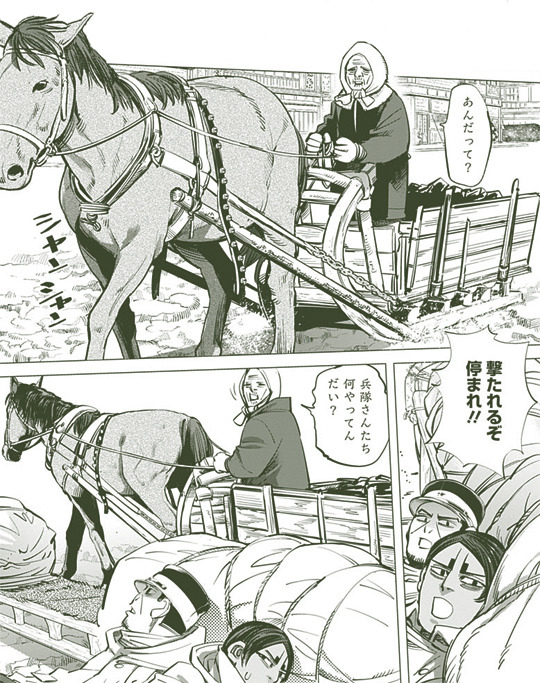
Ever wondered why streets are always so conveniently empty whenever there's a chasing or a shooting going on? I have, even if my question is probably answered in the same question already (because... they're so conveniently empty: easier to describe, draw or animate, and with a minimum of casualties, as well!) In any case, and even though our group seemed to be the only bystanders at the time the shooting began, there's now the usual traffic and activity you'd expect in a town street. In fact, a man in a sled is just walking down the street when, alerted by Koito and Tsukishima not to come that way or otherwise risk being shot, he good-naturally asked what the soldiers are doing. Tsukishima comments it seems as though Sugimoto has already done his magic, ie. he did what he's best at (hint: it isn't sniping or drawing, as we'll see in this chapter), and Asirpa runs off to meet him.
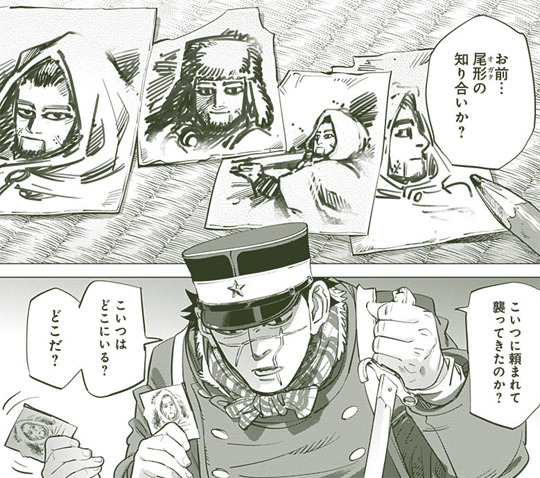
Here follows some good 4 pages of Sugimoto and Vasily proving the language barrier isn't an hindrance when it comes to relatively difficult tasks, such as explaining the events from vol.14 up to that point or how both of them have survived being shot in the head by the same sniper. It turns out Vasily has made enough drawings of Ogata to start his own Pixiv account -putting aside the fact that he's one century ago from that website being created-; actually, Vasily could begin posting full illustration logs, as he even took the care and time to draw the wildcat sporting different expressions, including one smiling. I'm suspecting he might have more study sketches of Ogata in the fiction than author Noda in the real world. This would pose a question for me: just how well could he see Ogata during their snipers' duel? In the extended passage as it was compiled in vol.17, they do spend many hours watching and studying each other... but let us not forget that Ogata's face was obscured in such a way, Vasily couldn't tell for sure where it was him or not. Well, following last chapter's caption at the end, I'm just going to assume here Vasily has nothing short of a photographic memory, sharpened to perfection through his sniping skills, and that he could commit to memory the features of a man he only seemed to have caught fleeting glimpses of partly because the wildcat is unforgettable. Being shot can arise that kind of reaction in people, after all. Going back to the chapter, and given the amount of Ogata portraits he has, Sugimoto asks him whether he's been requested to find him -bounty hunter-style, we may speculate-, but then Vasily uses some of his many (MANY) drawings to explain he went into a showdown with Ogata... and lost. This chapter's title could be translated as "portrait" (似顔絵, nigaoe), though its exact meaning would be more in the lines of a "drawn sketch/picture of a face". Why, yes, a portrait indeed, only that the term in Japanese suggests it isn't as precise as a taken photograph, but a close enough depiction.

I'm always making jokes and complaining about the cast in this manga being so prone to trust in others no matter what terms they might have been on in the past, but I have to admit that being able not to hold grudges, apart from preventing bitterness and anxiety in addition to other negative feelings, also helps greatly when it comes to pace the story forward. Remember how Sugimoto was about to kill Vasily in the best of Friday the 13th traditions (only that less bloody I might presume, given this is still a seinen manga and not a R-rated story), all of this happening in the previous chapter, 7 days ago in real time, 2 pages prior in the manga, like 10 seconds previously in the story's timeline? Well, let's put aside all that negativity for the sake of a couple of souls bonded by the same sniper (different bullet obviously, same rifle and all) sharing an artistic moment.
In addition to their fanboying over Ogata -for the wrong reasons, though, as they'd be both after the wildcat to settle some scores-, Sugimoto and Vasily manage to summarize the manga from vol.14 up to that point, using their respective drawings to explain to each other the events. "Explaining to each other" wouldn't be a wrong statement in this case because they do appear to be understanding the other quite well through the drawings, some gesturing, and the usefulness of somatic language, even though Vasily doesn't seem to know Japanese (as he's puzzled at Sugimoto's questions). When he produces drawings of Kiroranke, Shiraishi and Asirpa, Sugimoto explains to him the latter two aren't related to the Partisans: the bad guy here, no doubt about it, is Ogata, as he emphatically conveys by hitting his portrait with his fist. Now in quite the roll because Vasily is assimilating the ideas very fast (as he also hits Ogata's portrait), Sugimoto then explains he was also shot by the wildcat... and reveals his artistic sense might be on par with his sniping skills. ...and while I'll keep joking about his awful aiming until the day he finally manages to shoot anything down -as opposed to pummel or pierce it with his rifle or affixed bayonet-, I won't make much fun of his artistic capabilities because, I'm afraid, he might draw better than I. As I state in my blog's sidebar, I color manga panels partly because I can't draw a straight... or crooked... line for the love of it.
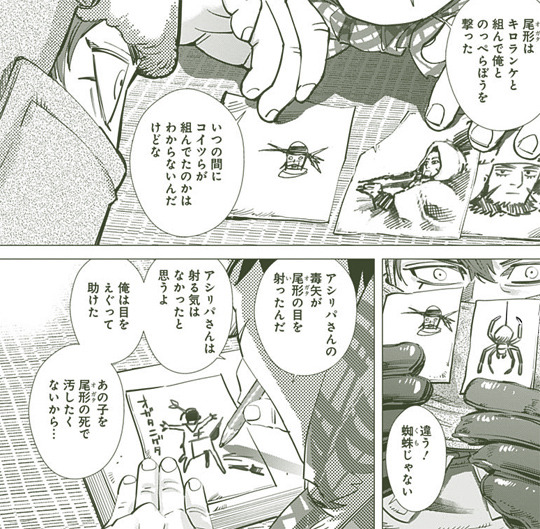
Sugimoto explains Ogata was in cahoots with Kiroranke -and as well as the readers, he doesn't how for how long-, shot him in the head in Abashiri Prison and then ran away taking Asirpa with him. Unlike their previous exchange, I can deduce Vasily didn't get a single word of any of it, as he mistakes Sugimoto's drawing of himself for a spider. And I must confess it took me some time to realize Sugimoto drew himself being shot: those tendril-like things sticking out of his head -that Vasily takes for a spider's legs, it seems- are meant to show the bullet's trajectory when impacting him. A parenthesis here: Let's just check Sugimoto's drawing of Ogata running away on horseback. I don't pretend to make fun of it, but I still find quite the noteworthy detail that he draws Ogata with an arrow sticking out of his right eye, and not sparing even the lock of hair that frames his face. Or at least, I'm assuming that's a lock of hair on Ogata's head. The caption Sugimoto writes in katakana reads, "Ogata escaped". That scene, may I add, has been a fan favorite -mine included- and a source of inspiration for many works in the Japanese fandom. Some speculative fanworks have to do with the circumstances Ogata runs away, and thus some fans have posed quite the questions, ranging from where he got that horse, to whether it didn't hurt too much to ride it in such conditions as, you might remember, he was wearing a hospital gown only and had no underwear to speak of. If you take a closer look at the panel, however, you'll notice Ogata is carrying a sack when he's riding away, implying he managed to gather his belongings and probably a couple more things for the road, and thus wouldn't be dying on us due to exposure or some painful horse riding to wherever it was he ran away .
Back to our amateur artists (because I'm assuming Vasily's main occupation revolves about being a sniper... with an eidetic memory for faces and some outstanding artistic talent as bonus) and resuming his recapping of the latter half of the manga and unabated by the debatable poor reception his drawing skills might be getting, Sugimoto explains Asirpa involuntarily shot an arrow that hit Ogata in the eye. Here comes a short passage -it's a single panel, in fact- that killed my Japanese pretty dead, so I wouldn't risk a translation of it... though I think, it seems to me, I could grasp that blah blah etc. etc., Sugimoto further and quite lively states Ogata's death would have "stained" Asirpa -meaning, would have dirtied her hands-, and thus he saved the wildcat because he'd do anything in his power to keep everything surrounding her pure for her sake. The actual word in Japanese he uses is 綺麗 (kirei), which you might know as meaning "cute" and "pretty", but it can also be understood in the sense of "clean", "pure" or "neat." Given Sugimoto literally uses 汚い (kitanai), "dirty", "unclean" or "foul" (used as a verb in this case) to describe how Ogata's death would have impacted Asirpa, I'm going with "pure" in my previous sentence. ...I'm aware my explanation of Sugimoto's statement makes it sound as though he's belittling saving Ogata, but I can reassure you that his lines are way more poetic and moving: it's just that my Japanese -and my English, come to that- is just that lacking, sorry about this! The scene is more moving because Asirpa arrives at the precise moment to hear Sugimoto's words, but he doesn't notice her.
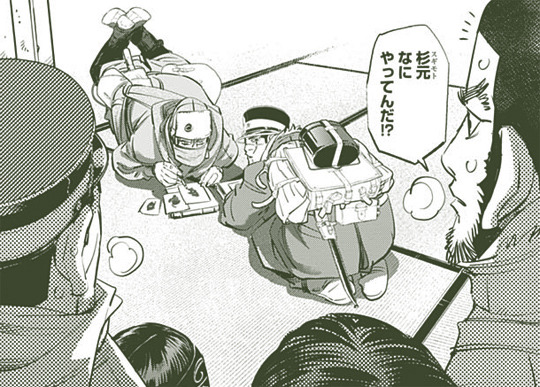
The rest of the group arrives and cuts off Sugimoto and Vasily's artistically driven moment of plot exposition, though. And now, please allow me to state that God bless Tsukishima for being himself, acting as the sane man every story needs, accompanying the group in this journey, and knowing Russian, not in that particular order: I'm 100% convinced this manga wouldn't progress half as smoothly as it does weren't he around. And Tsurumi and Koito wouldn't be probably around either if he didn't have that presence of mind and swiftness of action, specifically when projectiles and explosions are involved. After Asirpa says she thinks Vasily was part of the group of men that ambushed them in the frontier, Tsukishima explains to him Kiroranke is already dead and Ogata ran away, his whereabouts unknown to them. Their only purpose in Karafuto was to find Asirpa and go back with her, he adds, and they have nothing to do with the Czar's assassination by the Partisans. Vasily says nothing in the metaphorical sense, as he keeps quiet and seems to accept the explanation. Now, and I've already written above, I've always complained about the GK cast for being this trusty and, let's say, think nothing of the repeated risk of a headshot by accepting in their ranks a traitorous character who left their previous party after shooting a couple people in the head, but I have to admit yet again the characters being this quick to understand, accept and come to terms with practically anything and everything does help move forward the plot. Very much so.
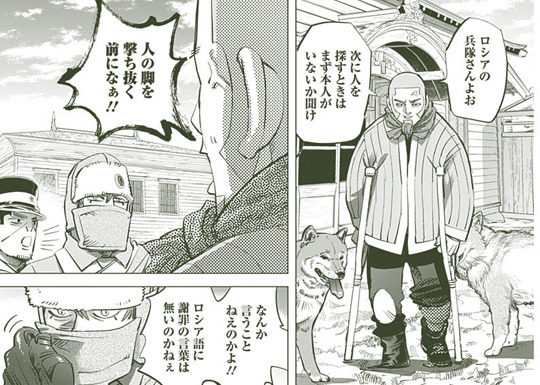
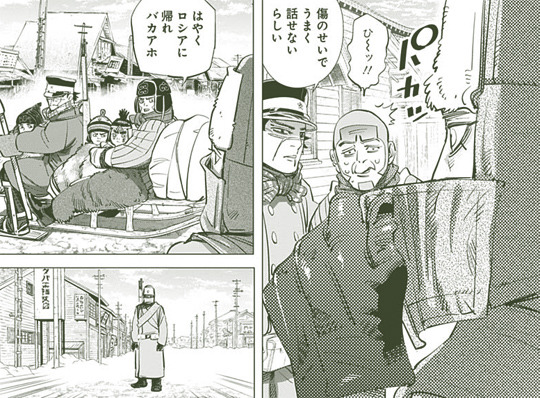
I wrote Vasily said nothing in the metaphorical sense because it's revealed -just as we were speculating- he can't speak due to the shot wounds he sustained during his duel with Ogata. Once outside, Shiraishi complains to him about shooting him; when our Escape King snaps whether he doesn't have anything to say or it's just that Russians don't know how to apologize (he literally asks whether there are no words for apologizing in Russian), Vasily shows him his face, prompting a reaction in Shiraishi that might make readers grateful we aren't shown the state of his lower face. Sugimoto comments at that moment he might not be able to speak due to those wounds. I was also wondering whether Vasily knew or at the very least could grasp a little Japanese. It seems to me he might not after all, as there are some panels throughout the chapter that show him with an interrogation mark -indicating he isn't understanding- when Sugimoto was talking to him. In the above panels as well, Tsukishima seems to be translating Shiraishi's complaints for him.

Just before the group resumes their journey, Shiraishi tells Vasily -in not so kind words- to go back to Russia, but he's shown to keep following them from a distance. Shiraishi ponders whether he doesn't believe Kiroranke is already dead, but Asirpa points out he used the back of Kiro's wanted poster to make some of his drawings, leading her to conclude he isn't interested in the latter anymore. As discussed by the our main protagonist trio, it seems Vasily is sticking to them under the belief they'll eventually cross paths with Ogata; as Sugimoto puts it, given he's still alive, he considers their snipers' duel to be not finished (I suppose a more poetic way to put it would be, "as long as he draws breath, he can keep fighting"). The immortal also thinks there's always the possibility of Ogata coming after them because of the Ainu gold, prompting Asirpa to wonder if that's actually his goal: let us not forget he showed quite the intent to kill her (chap.187) and thus, eliminate the one person who holds the key to solving the tattoo puzzle. A somewhat serious and pensive Sugimoto comments it might be that Ogata... is simply messing or toying around with them. Cue a full-page panel depicting a lynx (in Japanese, an ooyamaneko) crossing the path in the snowy forest. (I should point out I'm assuming it's a lynx because of its ears, making it very similar to the one shown in chap.169, vol.17.)
A not-so-random fan comment here: I always refer to Sugimoto as not being the sharpest knife in the drawer. Actually, I'd say he's the kind to smash the drawer against a wall and use the sharpest fragments of it to cut open whatever it is he might need cut, even if I'm compelled yet again to admit his approach, while not the most strategically planned, tends to work. But he also seems to be quite understanding of others in addition to his natural kindness, and it comes as not much of a surprise then that he could be the person with the better grasp at Ogata's personality. Or the only person who might have any grasp on it at all, in any case. I must say my opinion of Ogata's character pretty much coincides with that of Sugimoto as he stated it in chap.196 and now in this chapter: specifically, that Ogata doesn't have a particular motivation to act as he does (apart from being driven by the most negative and dangerous of his traits, of course). I think his character isn't meant to have any specific motivations or goals other than being chaotic for the sake of it; however, as Noda has given a background to every single recurrent and relevant character in the manga and spares no revelations for some of them no matter how far into the plot we might be (the most recent flashback regarding Koito's past should be an example), I can't discard the possibility of the author having in store some plot twist or equal revelation about Ogata.
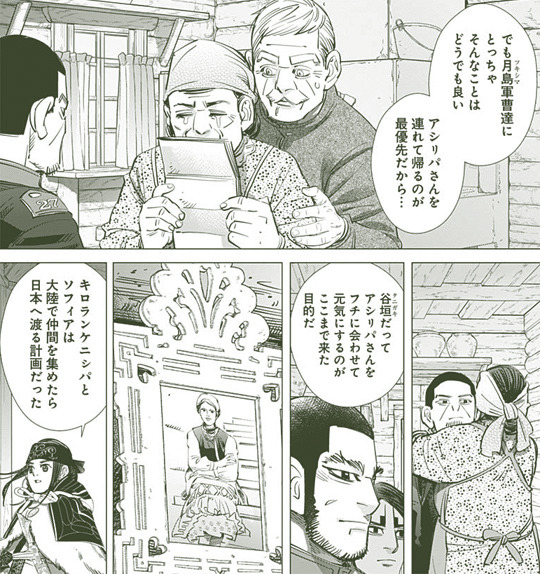
Given Sofia is the only one who knows the truth now (I'm assuming here Sugimoto thinks Ogata might have sided with Kiroranke for a reason that lies with the Partisans' intentions), our immortal comments he'd liked to look for her. He's aware, though, that Tsukishima and Koito's mission was to find Asirpa and get back with her to Hokkaido, whereas Tanigaki joined in the entourage for the sake of the girl as well and thus, they should have no reason to pursue other ends at the time. They still stop by the lighthouse to hand Svetlana's letter to her parents, and just as the manga implies they won't be going after more subplots, Asirpa points out Sofia was planning to reunite with her comrades in the continent and then go back to Japan: she wouldn't just run away to Europe after everything that just happened.
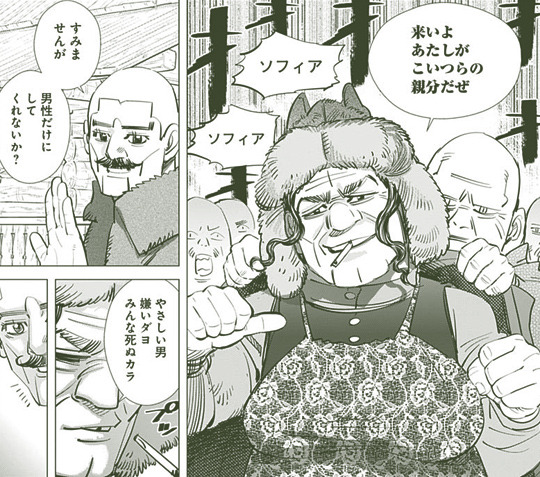
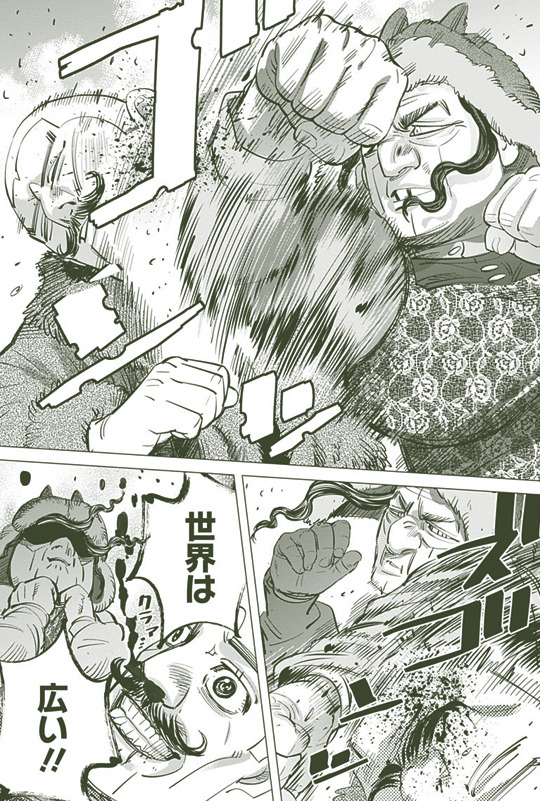
Right in cue, Sofia meets Gansoku and Svetlana in a port town in Russia. Just as Gansoku seemed to be involved in yet another cathartic moment pummeling around men who can't put a dent on him, he's challenged by Sofia but refuses, stating he only fights other men. He's quick to change his mind and declare the world does have many surprises in store ("The world is so wide!") after Sofia not only punches him, but manages to get in quite the equal grounds with him. This yet again poses another question for me: given Gansoku is one of the toughest men in this story -in the strictest physical sense at the very least: we can't forget everything Nikaidou has gone through the manga, after all-, how come Sofia can beat him so badly? The obvious answer would be that Sofia happens to be just that tough -or the toughest woman of the Meiji era-, but since this is a Shueisha and a Jump-published manga, I also want to believe she might be using Haki to hit that hard. Just as Nami in One Piece, her blows manage to harm a man's heart and soul.
Before their fight can further escalate (but after Sofia has pulled off the almost obligatory Rip Open my Shirt scene, only that she isn't exactly wearing a shirt and the scene isn't that common when female characters are involved because of censorship), Svetlana intervenes and stops them, saying it'll be quite the problem for her if Sofia kills her bodyguard. Implying here she was at least sure of what the outcome of the fight would have been. The three of them have a talk then and Sofia invites Gansoku to join her, but he turns down the offer and explains both he and Svetlana intend to make their way to the west, to the cities where a larger population means a larger possibility to find stronger people (to beat the **** out of them in more cathartic instances, I'm presuming). As Svetlana asks Sofia where she's planning to go now, she replies that she's going to Hokkaido... for their hope and revenge.
I should note I'm not including any more panels of Sofia in this chapter because I'm assuming Tumblr would flag this entry otherwise. I was never told why they put my blog "under review" when I barely had any posts on it, so my best guess has to with an entry I wrote explaining about the terrorist groups that operated in my country. I made that post partly because to poke some fun at Sugimoto's wielding a hammer and a sickle in chap.145 (vol.15), and how that would have been merited a ban for this manga were some conservative Congressmen in my country to see the panels (the largest terrorist group operating in my country originally followed the Communist ideology). Well, as Sofia begins exchanging blows with Gansoku, she uncovers her torso and her breasts remain visible for the rest of the chapter, even when she's speaking with him and Svetlana in the freezing Russian landscape. Her breasts are so big, they cover part of the chapter's title in the last page... making me suspect Tumblr could flag this entry just because her nipples are equally big.
Some (more) fan comments on this chapter: The story is unfolding as I'd anticipated in a very broad way, as it seems Vasily will stick around with the group for at least some more chapters. While none has proposed an alliance, I don't think any will have any inconvenience cooperating with each other as long as their goals align: even if it's true Sugimoto's group isn't that elated at the possibility of meeting Ogata again, they're obviously expecting to cross paths with him in the future, and extra help is always welcomed. Specially if things come to a sniper against another sniper, I'd say: the manga is hinting at another confrontation between Vasily and Ogata. After all, Noda is a noteworthy narrator and all of his plot elements turn out to be relevant (even those related to food and cultural traditions which could have been seen at first as more trivia-informative to the reader than important to the plot), so I don't think he brought Vasily back to the story for no reason. Or just to show off Vasily's artistic talent, in any case, * ahem *. The plot would still have to take shape, but it seems to me all elements are aligning so that Noda can solve several pending subplots: Vasily's reappearance can tie up with the plot regarding the remaining member of the Partisans trio, Sofia, and also provides the proper scenario for Ogata to make it back to the story. It'd be a viable, solid and swift way to focus in the current open subplots before focusing on the main premise of the Ainu gold in Hokkaido.
I'd just speculate then about how soon the subplots would meet a resolution. I'm wondering whether we'll see the rest of this arc taking place in Karafuto, as Sugimoto's group has already made their way back to its southern region, whereas Sofia is in Russian soil, but making her way to Hokkaido. If Vasily doesn't have any trouble with following them to Hokkaido -given he's already in Japanese soil-, then I see no reason as to why the action might not unfold in the island that is the main stage of this manga, but I'm thinking this arc could wrap up while the group is still in Karafuto. We'd need to see at least one more chapter to see how things progress from this point on; unless Noda suddenly feels like jumping back to Hokkaido and showing us what Hijikata has been up to since vol.18 and whether Tsurumi reunited with his men already, with the arc “introduction“ over and the situation laid out to both the cast and the readers, chap.204 should serve as the starting point for the resolution of the current subplots.
My last fan comment of the entry has to do with Vasily. While I'm happy to see him back in the plot and sticking to the protagonist cast for the time being (and hoping he stays in the plot and with the cast for at least the remainder of this volume), his personality as shown in the current events has caught my attention. I wouldn't say he's that different or plain out-of-character in comparison to his first appearance in vol.17, but it's also true he now acts carefree enough as to join Sugimoto in a fanart-sharing moment, and is more emotional as opposed to his cool-headed demeanor during the ambush in the frontier. And adding to his minor hairstyle change, he also looks more youthful now, even if the only we get to see of his face are his eyes. We'd need to see more of him in upcoming chapters to have a better grasp at his character... but if you'd ask me, I'd say Noda has made some changes to his personality, or rather, is shaping his character in a different, though not drastic, way. Why? Well, it seems to me Vasily would fit our protagonist cast and all the weird things bound to happen in this convulsed Meiji era just fine and even better now; in comparison, the group he first appeared as part of acted colder, more focused and serious. Until we see more of him, I'm just going to assume Noda decided to give his character another direction because Tsukishima was plenty of a sane, serious man for the group. Any more sane men in the same group at the same time and I might begin doubting what happened to this manga.
16 notes
·
View notes
Text
Dr. Seward's Diary.
26 September. -- Truly there is no such thing as finality. Not a week since I said "Finis," and yet here I am starting fresh again, or rather going on with the same record. Until this afternoon I had no cause to think of what is done. Renfield had become, to all intents, as sane as he ever was. He was already well ahead with his fly business; and he had just started in the spider line also; so he had not been of any trouble to me. I had a letter from Arthur, written on Sunday, and from it I gather that he is bearing up wonderfully well. Quincey Morris is with him, and that is much of a help, for he himself is a bubbling well of good spirits. Quincey wrote me a line too, and from him I hear that Arthur is beginning to recover something of his old buoyancy; so as to them all my mind is at rest. As for myself, I was settling down to my work with the enthusiasm which I used to have for it, so that I might fairly have said that the wound which poor Lucy left on me was becoming cicatrised. Everything is, however, now reopened; and what is to be the end God only knows. I have an idea that Van Helsing thinks he knows, too, but he will only let out enough at a time to whet curiosity. He went to Exeter yesterday, and stayed there all night. To-day he came back, and almost bounded into the room at about half-past five o’clock, and thrust last night's "Westminster Gazette" into my hand.
"What do you think of that?" he asked as he stood back and folded his arms.
I looked over the paper, for I really did not know what he meant; but he took it from me and pointed out a paragraph about children being decoyed away at Hampstead. It did not convey much to me, until I reached a passage where it described small punctured wounds on their throats. An idea struck me, and I looked up. "Well?" he said.
"It is like poor Lucy's."
"And what do you make of it?"
"Simply that there is some cause in common. Whatever it was that injured her has injured them." I did not quite understand his answer:---
"That is true indirectly, but not directly."
"How do you mean, Professor?" I asked. I was a little inclined to take his seriousness lightly -- for, after all, four days of rest and freedom from burning, harrowing anxiety does help to restore one's spirits -- but when I saw his face, it sobered me. Never, even in the midst of our despair about poor Lucy, had he looked more stern.
"Tell me!" I said. "I can hazard no opinion. I do not know what to think, and I have no data on which to found a conjecture."
"Do you mean to tell me, friend John, that you have no suspicion as to what poor Lucy died of; not after all the hints given, not only by events, but by me?"
"Of nervous prostration following on great loss or waste of blood."
"And how the blood lost or waste?" I shook my head. He stepped over and sat down beside me, and went on:---
"You are clever man, friend John; you reason well, and your wit is bold; but you are too prejudiced. You do not let your eyes see nor your ears hear, and that which is outside your daily life is not of account to you. Do you not think that there are things which you cannot understand, and yet which are; that some people see things that others cannot? But there are things old and new which must not be contemplate by men's eyes, because they know -- or think they know -- some things which other men have told them. Ah, it is the fault of our science that it wants to explain all; and if it explain not, then it says there is nothing to explain. But yet we see around us every day the growth of new beliefs, which think themselves new; and which are yet but the old, which pretend to be young -- like the fine ladies at the opera. I suppose now you do not believe in corporeal transference. No? Nor in materialisation. No? Nor in astral bodies. No? Nor in the reading of thought. No? Nor in hypnotism -- -- "
"Yes," I said. "Charcot has proved that pretty well." He smiled as he went on: "Then you are satisfied as to it. Yes? And of course then you understand how it act, and can follow the mind of the great Charcot -- alas that he is no more! -- into the very soul of the patient that he influence. No? Then, friend John, am I to take it that you simply accept fact, and are satisfied to let from premise to conclusion be a blank? No? Then tell me -- for I am student of the brain -- how you accept the hypnotism and reject the thought reading. Let me tell you, my friend, that there are things done to-day in electrical science which would have been deemed unholy by the very men who discovered electricity -- who would themselves not so long before have been burned as wizards. There are always mysteries in life. Why was it that Methuselah lived nine hundred years, and 'Old Parr' one hundred and sixty-nine, and yet that poor Lucy, with four men's blood in her poor veins, could not live even one day? For, had she live one more day, we could have save her. Do you know all the mystery of life and death? Do you know the altogether of comparative anatomy and can say wherefore the qualities of brutes are in some men, and not in others? Can you tell me why, when other spiders die small and soon, that one great spider lived for centuries in the tower of the old Spanish church and grew and grew, till, on descending, he could drink the oil of all the church lamps? Can you tell me why in the Pampas, ay and elsewhere, there are bats that come at night and open the veins of cattle and horses and suck dry their veins; how in some islands of the Western seas there are bats which hang on the trees all day, and those who have seen describe as like giant nuts or pods, and that when the sailors sleep on the deck, because that it is hot, flit down on them, and then -- and then in the morning are found dead men, white as even Miss Lucy was?"
"Good God, Professor!" I said, starting up. "Do you mean to tell me that Lucy was bitten by such a bat; and that such a thing is here in London in the nineteenth century?" He waved his hand for silence, and went on:---
"Can you tell me why the tortoise lives more long than generations of men; why the elephant goes on and on till he have seen dynasties; and why the parrot never die only of bite of cat or dog or other complaint? Can you tell me why men believe in all ages and places that there are some few who live on always if they be permit; that there are men and women who cannot die? We all know -- because science has vouched for the fact -- that there have been toads shut up in rocks for thousands of years, shut in one so small hole that only hold him since the youth of the world. Can you tell me how the Indian fakir can make himself to die and have been buried, and his grave sealed and corn sowed on it, and the corn reaped and be cut and sown and reaped and cut again, and then men come and take away the unbroken seal and that there lie the Indian fakir, not dead, but that rise up and walk amongst them as before?" Here I interrupted him. I was getting bewildered; he so crowded on my mind his list of nature's eccentricities and possible impossibilities that my imagination was getting fired. I had a dim idea that he was teaching me some lesson, as long ago he used to do in his study at Amsterdam; but he used then to tell me the thing, so that I could have the object of thought in mind all the time. But now I was without this help, yet I wanted to follow him, so I said:---
"Professor, let me be your pet student again. Tell me the thesis, so that I may apply your knowledge as you go on. At present I am going in my mind from point to point as a mad man, and not a sane one, follows an idea. I feel like a novice lumbering through a bog in a mist, jumping from one tussock to another in the mere blind effort to move on without knowing where I am going."
"That is good image," he said. "Well, I shall tell you. My thesis is this: I want you to believe."
"To believe what?"
"To believe in things that you cannot. Let me illustrate. I heard once of an American who so defined faith: ‘that faculty which enables us to believe things which we know to be untrue.’ For one, I follow that man. He meant that we shall have an open mind, and not let a little bit of truth check the rush of a big truth, like a small rock does a railway truck. We get the small truth first. Good! We keep him, and we value him; but all the same we must not let him think himself all the truth in the universe."
"Then you want me not to let some previous conviction injure the receptivity of my mind with regard to some strange matter. Do I read your lesson aright?"
"Ah, you are my favourite pupil still. It is worth to teach you. Now that you are willing to understand, you have taken the first step to understand. You think then that those so small holes in the children's throats were made by the same that made the hole in Miss Lucy?"
"I suppose so." He stood up and said solemnly:---
"Then you are wrong. Oh, would it were so! but alas! no. It is worse, far, far worse."
"In God's name, Professor Van Helsing, what do you mean?" I cried.
He threw himself with a despairing gesture into a chair, and placed his elbows on the table, covering his face with his hands as he spoke:---
"They were made by Miss Lucy!"
For a while sheer anger mastered me; it was as if he had during her life struck Lucy on the face. I smote the table hard and rose up as I said to him:---
"Dr. Van Helsing, are you mad?" He raised his head and looked at me, and somehow the tenderness of his face calmed me at once. "Would I were!" he said. "Madness were easy to bear compared with truth like this. Oh, my friend, why, think you, did I go so far round, why take so long to tell you so simple a thing? Was it because I hate you and have hated you all my life? Was it because I wished to give you pain? Was it that I wanted, now so late, revenge for that time when you saved my life, and from a fearful death? Ah no!"
"Forgive me," said I. He went on:---
"My friend, it was because I wished to be gentle in the breaking to you, for I know you have loved that so sweet lady. But even yet I do not expect you to believe. It is so hard to accept at once any abstract truth, that we may doubt such to be possible when we have always believed the 'no' of it; it is more hard still to accept so sad a concrete truth, and of such a one as Miss Lucy. To-night I go to prove it. Dare you come with me?"
This staggered me. A man does not like to prove such a truth; Byron excepted from the category, jealousy.
"And prove the very truth he most abhorred." He saw my hesitation, and spoke:---
"The logic is simple, no madman's logic this time, jumping from tussock to tussock in a misty bog. If it be not true, then proof will be relief; at worst it will not harm. If it be true! Ah, there is the dread; yet very dread should help my cause, for in it is some need of belief. Come, I tell you what I propose: first, that we go off now and see that child in the hospital. Dr. Vincent, of the North Hospital, where the papers say the child is, is friend of mine, and I think of yours since you were in class at Amsterdam. He will let two scientists see his case, if he will not let two friends. We shall tell him nothing, but only that we wish to learn. And then -- -- "
"And then?" He took a key from his pocket and held it up. "And then we spend the night, you and I, in the churchyard where Lucy lies. This is the key that lock the tomb. I had it from the coffin-man to give to Arthur." My heart sank within me, for I felt that there was some fearful ordeal before us. I could do nothing, however, so I plucked up what heart I could and said that we had better hasten, as the afternoon was passing...
We found the child awake. It had had a sleep and taken some food, and altogether was going on well. Dr. Vincent took the bandage from its throat, and showed us the punctures. There was no mistaking the similarity to those which had been on Lucy's throat. They were smaller, and the edges looked fresher; that was all. We asked Vincent to what he attributed them, and he replied that it must have been a bite of some animal, perhaps a rat; but, for his own part, he was inclined to think that it was one of the bats which are so numerous on the northern heights of London. "Out of so many harmless ones," he said, "there may be some wild specimen from the South of a more malignant species. Some sailor may have brought one home, and it managed to escape; or even from the Zoölogical Gardens a young one may have got loose, or one be bred there from a vampire. These things do occur, you know. Only ten days ago a wolf got out, and was, I believe, traced up in this direction. For a week after, the children were playing nothing but Red Riding Hood on the Heath and in every alley in the place until this ‘bloofer lady’ scare came along, since when it has been quite a gala-time with them. Even this poor little mite, when he woke up to-day, asked the nurse if he might go away. When she asked him why he wanted to go, he said he wanted to play with the ‘bloofer lady.’”
"I hope," said Van Helsing, "that when you are sending the child home you will caution its parents to keep strict watch over it. These fancies to stray are most dangerous; and if the child were to remain out another night, it would probably be fatal. But in any case I suppose you will not let it away for some days?"
"Certainly not, not for a week at least; longer if the wound is not healed."
Our visit to the hospital took more time than we had reckoned on, and the sun had dipped before we came out. When Van Helsing saw how dark it was, he said:---
"There is no hurry. It is more late than I thought. Come, let us seek somewhere that we may eat, and then we shall go on our way."
We dined at "Jack Straw's Castle" along with a little crowd of bicyclists and others who were genially noisy. About ten o’clock we started from the inn. It was then very dark, and the scattered lamps made the darkness greater when we were once outside their individual radius. The Professor had evidently noted the road we were to go, for he went on unhesitatingly; but, as for me, I was in quite a mixup as to locality. As we went further, we met fewer and fewer people, till at last we were somewhat surprised when we met even the patrol of horse police going their usual suburban round. At last we reached the wall of the churchyard, which we climbed over. With some little difficulty -- for it was very dark, and the whole place seemed so strange to us -- we found the Westenra tomb. The Professor took the key, opened the creaky door, and standing back, politely, but quite unconsciously, motioned me to precede him. There was a delicious irony in the offer, in the courtliness of giving preference on such a ghastly occasion. My companion followed me quickly, and cautiously drew the door to, after carefully ascertaining that the lock was a falling, and not a spring, one. In the latter case we should have been in a bad plight. Then he fumbled in his bag, and taking out a matchbox and a piece of candle, proceeded to make a light. The tomb in the day-time, and when wreathed with fresh flowers, had looked grim and gruesome enough; but now, some days afterwards, when the flowers hung lank and dead, their whites turning to rust and their greens to browns; when the spider and the beetle had resumed their accustomed dominance; when time-discoloured stone, and dust-encrusted mortar, and rusty, dank iron, and tarnished brass, and clouded silver-plating gave back the feeble glimmer of a candle, the effect was more miserable and sordid than could have been imagined. It conveyed irresistibly the idea that life -- animal life -- was not the only thing which could pass away.
Van Helsing went about his work systematically. Holding his candle so that he could read the coffin plates, and so holding it that the sperm dropped in white patches which congealed as they touched the metal, he made assurance of Lucy's coffin. Another search in his bag, and he took out a turnscrew.
"What are you going to do?" I asked.
"To open the coffin. You shall yet be convinced." Straightway he began taking out the screws, and finally lifted off the lid, showing the casing of lead beneath. The sight was almost too much for me. It seemed to be as much an affront to the dead as it would have been to have stripped off her clothing in her sleep whilst living; I actually took hold of his hand to stop him. He only said: "You shall see," and again fumbling in his bag, took out a tiny fret-saw. Striking the turnscrew through the lead with a swift downward stab, which made me wince, he made a small hole, which was, however, big enough to admit the point of the saw. I had expected a rush of gas from the week-old corpse. We doctors, who have had to study our dangers, have to become accustomed to such things, and I drew back towards the door. But the Professor never stopped for a moment; he sawed down a couple of feet along one side of the lead coffin, and then across, and down the other side. Taking the edge of the loose flange, he bent it back towards the foot of the coffin, and holding up the candle into the aperture, motioned to me to look.
I drew near and looked. The coffin was empty.
It was certainly a surprise to me, and gave me a considerable shock, but Van Helsing was unmoved. He was now more sure than ever of his ground, and so emboldened to proceed in his task. "Are you satisfied now, friend John?" he asked.
I felt all the dogged argumentativeness of my nature awake within me as I answered him:---
"I am satisfied that Lucy's body is not in that coffin; but that only proves one thing."
"And what is that, friend John?"
"That it is not there."
"That is good logic," he said, "so far as it goes. But how do you -- how can you -- account for it not being there?"
"Perhaps a body-snatcher," I suggested. "Some of the undertaker's people may have stolen it." I felt that I was speaking folly, and yet it was the only real cause which I could suggest. The Professor sighed. "Ah well!" he said, "we must have more proof. Come with me."
He put on the coffin-lid again, gathered up all his things and placed them in the bag, blew out the light, and placed the candle also in the bag. We opened the door, and went out. Behind us he closed the door and locked it. He handed me the key, saying: "Will you keep it? You had better be assured." I laughed -- it was not a very cheerful laugh, I am bound to say -- as I motioned him to keep it. "A key is nothing," I said; "there may be duplicates; and anyhow it is not difficult to pick a lock of that kind." He said nothing, but put the key in his pocket. Then he told me to watch at one side of the churchyard whilst he would watch at the other. I took up my place behind a yew-tree, and I saw his dark figure move until the intervening headstones and trees hid it from my sight.
It was a lonely vigil. Just after I had taken my place I heard a distant clock strike twelve, and in time came one and two. I was chilled and unnerved, and angry with the Professor for taking me on such an errand and with myself for coming. I was too cold and too sleepy to be keenly observant, and not sleepy enough to betray my trust so altogether I had a dreary, miserable time.
Suddenly, as I turned round, I thought I saw something like a white streak, moving between two dark yew-trees at the side of the churchyard farthest from the tomb; at the same time a dark mass moved from the Professor's side of the ground, and hurriedly went towards it. Then I too moved; but I had to go round headstones and railed-off tombs, and I stumbled over graves. The sky was overcast, and somewhere far off an early cock crew. A little way off, beyond a line of scattered juniper-trees, which marked the pathway to the church, a white, dim figure flitted in the direction of the tomb. The tomb itself was hidden by trees, and I could not see where the figure disappeared. I heard the rustle of actual movement where I had first seen the white figure, and coming over, found the Professor holding in his arms a tiny child. When he saw me he held it out to me, and said:---
"Are you satisfied now?"
"No," I said, in a way that I felt was aggressive.
"Do you not see the child?"
"Yes, it is a child, but who brought it here? And is it wounded?" I asked.
"We shall see," said the Professor, and with one impulse we took our way out of the churchyard, he carrying the sleeping child.
When we had got some little distance away, we went into a clump of trees, and struck a match, and looked at the child's throat. It was without a scratch or scar of any kind.
"Was I right?" I asked triumphantly.
"We were just in time," said the Professor thankfully.
We had now to decide what we were to do with the child, and so consulted about it. If we were to take it to a police-station we should have to give some account of our movements during the night; at least, we should have had to make some statement as to how we had come to find the child. So finally we decided that we would take it to the Heath, and when we heard a policeman coming, would leave it where he could not fail to find it; we would then seek our way home as quickly as we could. All fell out well. At the edge of Hampstead Heath we heard a policeman's heavy tramp, and laying the child on the pathway, we waited and watched until he saw it as he flashed his lantern to and fro. We heard his exclamation of astonishment, and then we went away silently. By good chance we got a cab near the "Spaniards," and drove to town.
I cannot sleep, so I make this entry. But I must try to get a few hours' sleep, as Van Helsing is to call for me at noon. He insists that I shall go with him on another expedition.
3 notes
·
View notes
Text
Netflix Sees Their Audience As Objects... Here’s Why.

Now that the fall has rolled around, Netflix has been continuously providing us with new shows, movies and additional seasons to the series we are already invested in. Logging onto Netflix recently caught my attention, as I began to see the streaming application in a different light. No longer do I see the popular site as just a place for me to binge on my favourite shows while letting out the stress after a three-hour lecture on the history of silent cinema, but I have been beginning to see Netflix as an application notorious for one thing- target marketing. I used to view the shows the site suggested for me as beneficial for my particular viewing habits, and never really thought much of the practice until recently. Now, logging in with the abundance of Halloween specials all I can imagine are the algorithms the developers have set out to keep me invested in their service. Does Netflix really value me as a customer, or am I just another number? I can justify my thought of myself and the millions included in the Netflix audience as simply objects, using a five-question approach.

What if our “choices” (as a result of target marketing – and as indicated by media ratings) are not really choices?
Netflix surprises me with what they suggest, especially when considering the fact that whether I am using my profile on my mother’s account, or the profile on my father’s account, where I essentially watch the exact same programs, I always receive obscure suggestions that I somehow always end up watching, whether or not they coincide with the programs I have viewed. I enjoy watching raunchy comedies, and my viewing history makes this clear as I constantly re-watch shows such as Family Guy and films such as Superbad and Pineapple Express. However, when my suggestions include sappy, romantic, holiday films such as A Christmas Prince, and I choose to watch it, no matter how much I hate myself after, I begin to argue whether or not I actually did choose to watch the program. Of course, physically I did select that specific film to watch while at home on a Friday evening as opposed to the hundreds of raunchy comedies available to me. Aside from my physical decision, I would argue that in some ways, I did not have a choice and that Netflix has an almost sadistic way of pulling viewers into the original series they want us to engage with. I did not watch A Christmas Prince because I was interested in it, but I feel like with the publicity the film received, to the point where official Netflix accounts were essentially making fun of the viewers who watched the film every single day was what caused me to view the film. I did not choose A Christmas Prince, Netflix chose it for me with their genius marketing tactics and way of making us feel obligated to jump on the viewing bandwagon.
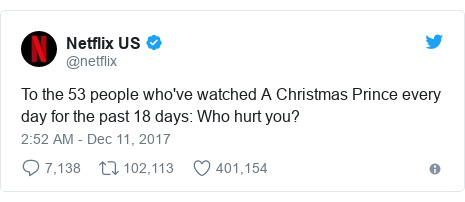
What if we’re doing all the work?
With this question, I feel somewhat neutral towards the answer. I do feel as if we are unconsciously doing work when watching Netflix, but I consider most of the time I spend binge-watching as a form of leisure. Watching my favourite Netflix programs becomes a stress-reliever for me, where I can sit back, under the covers while watching shows or movies that I enjoy. Occasionally, I can multi-task while watching familiar shows where I am not afraid to miss certain scenes as I have already seen the episode a dozen times. I can finish my homework, clean my room or cook dinner all while continuing to let Netflix play in the background. In this sense, I do not consider to be doing work because watching television helps me to relax and unwind after a long day. If anything, I would consider watching Netflix to be the opposite of work, yet unconsciously there can be an argument that we are doing work for the bigger picture. Netflix chooses programs carefully based on viewer reception, and without the work from us, the audience, how could Netflix possibly know what shows their demographics want to see on their website? Perhaps we are doing a tremendous amount of work with minimal effort. Audiences as objects are the key component to keeping Netflix thriving on success. Without an audience to collect and interpret data, influencing their overall marketing schemes, the company would arguably face a decline in the overall satisfaction rates gained from viewers excited to see that a new season of their favourite show has been added, based on popular demand.

What if ratings and marketing have turned us into data?
After investigating the help section of the official Netflix website, I stumbled across an illustration of how the site’s recommendation section actually works. Netflix studies several patterns connected with our viewing. They monitor our viewing history as well as the history of other members with similar habits, and information on the shows themselves such as the actors, directors and year released. Additionally, the site monitors the time of day we tend to watch Netflix, what device we choose to watch on and for how long we watch in a single viewing period. All of this data is input into Netflix’s complex algorithms which output a design that satisfies a personalized viewing experience. After reading this, I strongly stand by my argument that we are seen as “objects” to the big-wigs over at the Netflix headquarters. Though the site claims to be creating an enjoyable experience for us, specifically, I doubt the programs on my recommendation list differ that much from other users. Even after comparing suggested titles on my account versus my mother’s account, it is clear that despite the different tastes we both have, we both feel forced into engaging with whatever Netflix original is trending based on what “everyone is watching”. Computers pumping out numbers, almost like a dating site, matchmaking me with programs the bots think I’ll enjoy does not feel personal to me.

What if ratings and marketing have made us unhappy?
After reading an article titled, Unhappy Endings, published by the site “Medium”, where the unsatisfactory ending to Game of Thrones is explored, I can argue that when studying popular opinion, sometimes ratings and marketing can make us unhappy. As much as I attempt to avoid spoilers regarding the program I am currently watching, sometimes it is inevitable as I log on for my daily morning browse of Reddit or Twitter. When I hear the negative discussions surrounding a film’s release, or a series’ end, I find it difficult to return back to that show or continue with my plans to see that movie. Why bother seeing a film if the general consensus has been negative? Surely, it will not be interpreted different by me, right? These are the questions that fill my mind, causing me unhappiness when I know deep down that I will be disappointed by something I had anticipated, or previously enjoyed. Ratings can make us unhappy, when studied in this specific scenario- no matter how much we love a director, or actor, or genre, when we see that low audience rating on whatever film Netflix is trying to pitch, do we continue with our plans to watch the program? I certainly do not, as a negative mindset heavily impacts my actions and opinions. This is yet another way of viewing Netflix customers as objects, as once again the notion of “jumping on the bandwagon” takes place. If everyone else is boycotting this film, or calling it an utter piece of trash, why bother engaging?

What if ratings and marketing have made the planet unhealthy?
Perhaps, after examining the above questions, our final argument can be that ratings and marketing can have an effect on the planet as a whole, and provide the global audience with unhealthy standards. We know that generally, television viewing is an unhealthy habit and one that should be done in moderation. With the rise of Netflix, and the site’s marketing techniques, this activity has evolved beyond moderation and has blown up into an ongoing event. Speaking from personal experience, I would estimate that I watch at least 5-6 hours of television in a single day, which is a drastic amount compared to the fact that I should be sleeping at least 8 hours, attending school for 6 hours a day on average and studying at least another 3-4 hours each evening. Yet, Netflix has pulled me in and kept me hooked, like a dealer and his addict. I keep returning to Netflix when I hear people discussing the addition of new seasons of my favourite programs, and I always feel obligated to check out the buzz over whatever newest Netflix original is published. As I said earlier, sometimes I feel I lack freedom in choosing when I watch and what I watch on the app. I know how unhealthy a solidary lifestyle can be, yet I and millions of others who have fallen into the Netflix trap continue to go back for more. Netflix, and other streaming platforms, are addictive and have only added to the dangerous pattern of bingeing behaviour that humans have been known to partake in. Netflix views their customers as objects, and thrive on the publicity and financial support we provide, yet several, including myself, have failed to recognize the dangers held in simply being just one single number in a pool of millions.
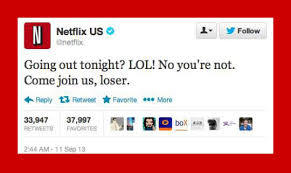
Sources
Ballard, C. (2019, July 16). Unhappy Endings. Retrieved from https://towardsdatascience.com/unhappy-endings-36e5fd157703.
How Netflix’s Recommendations System Works. (n.d.). Retrieved from https://help.netflix.com/en/node/100639.
1 note
·
View note
Text
Shards of Life: Chapter 5
Rating: T
Summary: There is magic in the world - perhaps there always has been. But the world is changing. The wielding of magic is changing.
There are those who seek to control it. Those who seek to destroy it. And those who seek to understand it… whatever the cost.
Elsa had three days to prepare for a trial, and no idea at all how to do so. She considered going to see the boy Bjorn, as the other expert – Alarik; she must work harder to remember names here, with no one to assist her – had done, but she had no idea what she might say or ask him, what might help her, or help him. She still had only the vaguest idea of what had actually happened in his home village – and as far as she could discern, that was all anyone else had. She was left, in the end, frustrated and somehow even more uncertain than she had been before. What in heaven's name did they actually want from her? She spent her first night in Leisalla curled in her unfamiliar bed – she had never before considered the importance of having one's own pillow – hoping for sleep, well aware it was not coming, and trying to figure it out: what did they want? What did they expect? And why did she fear already that she was going to be destined to fail them? She fell into a fitful doze near the pale winter dawn, and was awake again by midmorning. She got up then. She saw no reason not to do so. She wanted to go home. Strange sentiment, about a place where she had so long felt trapped – except, of course, she had realized quite some time ago that the true prison was her own mind. The Leisallan palace only magnified that truth She wanted home, with its mundane sights and sounds and smells, every corridor as familiar as her own face in the mirror, Anna always willing to hold her hand and talk of nothing in particular until the shakes and terrors passed. And that was the worst part: thoughts of Anna. Elsa should never have left her – and for all she knew, it was already too late to get back. She should write a letter – but what if the response came not from Anna, but from someone, anyone, else, regretfully informing her of the loss of both Anna and the baby? Which was worse – the anxious fear of ignorance, or the sorrow of sure knowledge? Elsa found her usual, cowardly escape: she buried herself in work. She asked the maid who brought her breakfast where she might find more information about what had happened with Bjorn, and perhaps some paper and ink? The maid promised to find out – and less than an hour later, there was another knock at the door. She couldn't hide her surprise when she opened it and found the scholar of magic – Alarik. He was wearing a jacket today, but it was threadbare and patched at the elbows, and his ridiculous curls were loose across his forehead. He had his arms full – of paper, newsprint, a book, a bottle of ink. He grinned down at her. "My apologies for intruding, Your Majesty. I was with Knut when the girl informed him you wanted more information on what happened. I spent several weeks gathering everything I could find before I got here. I thought you might find it useful?" It took her a moment to get her bearings – and to remember her manners. "Of course, thank you. Please, come in." "Where would you like these?" "Uh... here. Just in here is fine." She opened the door to the little library, and he put the stack on the table by the window. "This was always one of my favorite rooms," he said, taking a moment to peruse the shelves, his eyes bright and his smile easy. "There's the Erasmus Darwin Beata asked me to send – just to irritate her father, I suspect. He was deeply religious – very traditional." "You've been here before?" Elsa asked – a stupid question, as his comfort in the place had been obvious from the moment she had met him, but she still felt out of sorts from his unexpected appearance, and her years of etiquette training insisted she could not allow conversation to lapse. He glanced at her, still smiling, eyebrows raised, as if reading her thoughts on the question. "Many times. Knut was my patron when I was working on my doctorate. Ah – I meant to bring you a copy of my dissertation. It might help you understand better what I believe about the workings of Bjorn's powers – and your own." Elsa tensed, but kept her face carefully expressionless, and allowed what she hoped was a noncommittal noise. His second glance – smile gone – said clearly that she had been less than successful. "I don't meant to overstep bounds. My apologies. Again. I... I should have asked, not assumed you must be interested in it in the same way I am." He sounded sincere, enough so that Elsa felt herself soften, just a little bit. "I am interested. Really – I am. I'm just..." She sighed, and let her arms cross in familiar, protective gesture. She couldn't look at him, and instead let her eyes wander over the bookshelves, spines of black and brown and blue. "I'm just a little overwhelmed at the moment. I'm sorry." "No need." She could almost feel the return of his smile. "I'll leave you to your work – but if you'd like to discuss any of it, I would welcome hearing some thoughts besides my own. Knut just wants it over so he never has to think about it again, but... my mind won't rest so easily." Her eyes met his, just briefly, as he bowed to her, shoving hair from his face with absent habit. She managed a smile. "Thank you for bringing things." "My pleasure, Your Majesty." It wasn't until the door closed behind him that Elsa fully appreciated how tense and uncomfortable she had become – but why? Just because he was, like so many of his ilk, inclined to arrogance; prideful? She didn't think so – she dealt with pompous, self-important people almost on a daily basis, in her own government and in the delegates and the diplomats sent by others. He was certainly no worse than they were. No – it was more the subject of his arrogance, she thought, that left her so uncomfortable. He studied magic; he made his career, his name, and his living using people like her. She had read so much on magic, possibly even some of his own work, but she had never fully appreciated the level of scrutiny that must go into it, the vulnerability she felt to know when he looked at her, he believed he knew her better than she knew herself. She stood for a long time in the doorway of the tiny library, arms still crossed, trying to ignore the chill seeping through the air. Out the window, she could see the wide lawn, one little copse of trees leafless in the November cold – and the wall, separating completely this ancient palace from the ill-at-ease modern world without. Closed gates – it was so easy, to simply hide away. Elsa hugged herself a little tighter. Her unease, if she was honest with herself, went far deeper than just Alarik. And she desperately wanted to go home. She would – when her work here was done. No matter how well Alarik thought he understood Bjorn's magic, he had never experienced himself what it was like to have magic. Anna's voice, so clear, echoed within her memory: You may be all he's got. Elsa went to one of the high-backed chairs before the table, pulled the pile of things Alarik had brought closer to hand, and got to work. The book atop the stack proved to be a blank journal. She made copious notes, but was quickly made aware of the paucity of information. She felt a growing irritation, particularly as material began to repeat, again and again and again. It was mostly sensationalized nonsense from newspapers and illustrated journals, and the story of a 12-year-old boy killing by magic was featured alongside a mermaid captured in Fiji and a woman who claimed to be the reincarnation of Joan of Arc. One story had a disturbing line drawing of a feral-looking child laughing over the bodies of his family, hurled in dramatic, draping death around the shattered remains of their home. It was ridiculous – but it was also disquieting. Had they done similar stories following the events in Arendelle, after the coronation, Elsa with demonic eyes and ice dripping from her fingers? Surely, they had. And in the pit of her stomach, in the quickening beat of her heart, Elsa felt shame – the familiar embarrassment of childhood lapses in control; quiet servants mopping the floors, helping her out of sodden dresses still stiff with half-melted ice. She had yet to meet Bjorn, and she knew well it was possible he had done it deliberately, but... You may be all he's got. Lunch, like breakfast, was delivered – intended as a silent warning that she should stay put until told otherwise, or an acknowledgment that a need for privacy would be respected? Alarik had gone to see Bjorn yesterday, seemingly without asking any kind of permission – but he had, he'd told Elsa only hours before, known Knut and Leisalla well long before the current problem. Elsa was a stranger – and a stranger with the potential to create her own problems on top of the one they already had. She picked at her lunch. The food here was good, but even sliced herring couldn't draw much of an appetite from her. She pushed the plate aside, poured a second cup of tea, and sipped it, appreciating its warm sweetness, as she reviewed the notes she had made. As Knut had said the day before, Bjorn was by all accounts known by those in his village to have magic, but rural and poor as it was, that information seemed never to have reached the wider world. He was the second child born of his parents; his elder sister, believed to be 14 or 15, had married another villager several months before, and was, as a result, the only one in the family besides Bjorn to survive. Their parents, two younger sisters, a brother, and the widowed woman who rented a room in the Olavsson home had not been so lucky. Details grew sketchy, but the explosion – like someone "lined the earth below with powder, and threw a flame in after," according to one report – had sent enough rubble and debris up to destroy the house completely, and other structures in the village had collapsed as the ripples spread. That was where scores more were injured – the various stories could not agree on a number, but the lowest Elsa had seen was fifty. The village itself was decimated. And yes – as soldiers of the prince moved in, Bjorn had fought, and viciously. Those were the hardest accounts for Elsa to read. They wanted to further prove his monstrous nature. But, she reminded herself again, he could be a monster – people could be. She had known some. Magic did not create monstrosity, perhaps, but neither did it by mere existence prevent it. She spent the afternoon trying to read one of the books in the library – an account of the life of Saint Magnus. How many years had she spent finding ways to distract herself? It had once been second nature. But her attention now wandered and waned, and she finally gave up, returning the book to its place on the shelf and turning, once more, to the stories about Bjorn. She was called – invited? - to dinner with Knut and Beata; there was no sign or mention of Alarik. Knut seemed irritated and distant, but Beata was as open as she had been the day before. She sat next to Elsa; today in – Elsa couldn't fully hide her surprise – a silk cravat of deep peacock blue and an odd plumed hat of the same color. "So what is Arendelle like?" she asked. She had a full plate before her, but hadn't even picked up her fork. "It's..." How to describe a place she often times still felt she barely knew herself? Anna knew every corner and crevice. "It's very mountainous, but... beautiful. Very beautiful." "I'd ask for more than that!" Beata said, and laughed. Across the table, a silent servant poured Knut his third glass of port. "What are the people like?" "They're... my sister Anna once told me a diplomat said the people are Arendelle are too dour. She thought that was very funny. Anna is... She's not dour at all." Mentioning Anna was a mistake – the worry, the fear, washed over her once more, and she had to put her own fork down to clench her hands in her lap, hidden beneath the table. Nonetheless, she saw Beata's eyes dart down, and up again – hardly a glance. "Do you travel often?" Elsa managed a smile. "This is my first time out of Arendelle." "Really? This place is so dull, I'll be afraid it will put you off ever going anywhere again. I went to Greece last summer – did you know the Parthenon is named for Athena Parthenos, Athena the Virgin?" Elsa let her talk – telling of the sultans of the Ottoman Empire, the enormous palaces of Russia, Moorish architecture in Spain – and felt herself slowly, very slowly, begin to relax. She ate sparingly, mostly to be polite; Beata ate nothing at all. The dining room was small and dark and quiet; Beata was a good storyteller, using her hands to punctuate the words, her eyes bright with memory. And Elsa was surprised to realize – as servants cleared plates, bringing in brandy and thin-sliced cake – that she felt almost at ease. That feeling was immediately obviated when Knut finally spoke up. "Beowulf said he gave you everything we've got on the boy, Queen Elsa?" Beata sat back without another word, leaving Elsa to wonder what she had missed earlier today – all the lighthearted air of the day before was gone. She looked to Knut – his face flushed, dark shadows beneath his eyes. "He did, yes, thank you." "What did you think?" She hesitated, carefully folding her hands together once more, resisting the inclination to bite her lip. There was so much more going on here than she knew – certainly, more than one 12-year-old boy. "I think... I think I'd... I'd like to speak to Bjorn myself, if possible?" Knut shook his head. "Sadly, Your Majesty, it is no longer possible. Though he still hasn't shown any magic at his current location, he's turned violent again. He attacked one of the guards today, bit him, in fact, quite a nasty bite, from the report I received. The boy sounds more animal than human, frankly." Elsa clenched her hands more tightly. "I did wonder, when you said yesterday he hasn't used magic here – are you sure he actually has it?" "He has it," Knut said. "I've had to spend a fortune sending people up to that godforsaken village to speak to witnesses. He most certainly has it." "Alarik says he has the cells, too," Beata added. "Has Alarik been to see him again?" Elsa asked. Knut shrugged. "I don't believe so, but I haven't seen him since this morning." "He isn't banned, as well?” "It would be significantly more of a diplomatic upset if you were injured, Your Majesty." There was sympathy in his voice, but Elsa still clung to the irritation that had flared – it was easier to control than fear. "I'm not sure how much help I can be, in that case." "If you aren't at the trial, I have no doubt – the boy will hang." Elsa's hands shook, even entwined around one another, but she forced her eyes to meet Knut's. "You couldn't step in to save him?" He shrugged again, and seemed to find sudden interest in watching the swirling contents of his glass. "Legally, yes – if I want to be the one to hang instead. You've seen what's happening out there." Elsa had nothing to say to that, but she nursed her anger, and wondered how much stronger it might grow before her time here was done.
Sleep came more readily that night – Elsa suspected it was from pure exhaustion – but she woke with dawn still only a smudge of light beyond the wall. A light snow had fallen in the night, blanketing the lawns around the palace, and Elsa felt oddly comforted to see it: it was as if an old friend had come to visit. She sat cross-legged on the bed, watching the sky slowly lighten – as little as it truly did, this late in the year. It was less than a month to the Winter Solstice – folk wisdom in Arendelle said the weather on the solstice predicted the severity of the rest of winter. She would turn 25 on the solstice. But that, of course, led her mind back to Anna, and her stomach clenched as tightly as her hands around the blankets beneath her. Not knowing – it would never get any easier, with no word, no way to know if... If Anna was already gone. She pushed up, off the bed, before it froze beneath her. As quickly as that, the calm was lost, the storm returned, leaving her breath shallow and her hands trembling as she dressed, brushed her hair, braided and pinned it up. There was nothing she could do – she tried to convince herself of that, that there was nothing to be gained by dwelling on it. But, as always, it was not enough. She paced, just around her rooms, movement somewhat keeping the cold at bay – though she knew it was there, still, lurking beneath her skin. How was she supposed to feel anything but sympathy for Bjorn, knowing what her own powers had done? She forced down half her breakfast – she knew all too well how difficult it became to function without food. And again, she then took tea to her work – lacking any other ideas, she pulled from the shelves some of the books on biology. If Alarik sided with Knut – who clearly had no intention of trying to save Bjorn, guilty or not – maybe she could find counterarguments. She would ask for a copy of Alarik's dissertation, perhaps, after all – but for now, she would work with what she had. Her mind struggled to return to Anna – to dwell on what-ifs and might-have-beens – and she fought grimly back, determined to achieve something for someone, even if it couldn't be Anna. She worked her way through chapters on human development, brain function, nervous conditions. She made more notes – speculation on differences between the minds of children and adults; particular patterns of conduct often seen in men found guilty of violent crime; damage to various areas of the brain and the resulting behavioral changes. But all the notes in the world couldn't make up for not having a chance to speak to Bjorn. If she could even just see him, it might help. She had no idea how trials worked here – in Arendelle, they were a matter for parliament, rarely involving Elsa directly, but Leisalla did not have a parliament. She should have asked. She should have done so many things. She turned to another book. It was late morning when the knock came at the door – a knock far more hesitant than those of the servants. She opened it to find Beata, today in a long overcoat of blue-and-lavender checks, sturdy black boots, and with a pale blue scarf tied over her hair. She smiled. "Want to get out for awhile?" Elsa was taken aback, but said, "That might be... that might be nice." "Wonderful! Since I already asked Niko to saddle the horses." Elsa was not a confident rider – as in so many things, Anna was the more talented one ahorse – but her little Northlands pony proved even-gaited and easy to control. She liked him. And it was nice to be out of the confines of the heavy air and mazelike halls of the palace. The air was frigid and dry, the thin layer of snow crunched pleasantly beneath their ponies' hooves, and Elsa breathed deeply: cold and woodsmoke and, somewhere nearby, the oddly dark smell of the last of autumn's apples, left to waste away beneath the trees. They rode for a time in silence, away from the palace, to the vast open parkland that seemed to stretch on for forever beyond it. But finally, quietly, Beata said, "I hope Knut didn't upset you last night. If he did, he'll never honestly apologize, but... I will." Elsa looked at her, surprised, but Beata was staring firmly straight ahead. Her cheeks were flushed pink with cold. "No," Elsa said. "No, it was... it was fine. I know his position is difficult." Beata turned then, flashing a grin. "You would know that better than most, I imagine." Elsa's own smile felt tight, but genuine. "Oh, yes." But Beata sighed, a moment later, and her face once more grew pensive. "Knut would have done better a century ago – when society still accepted... royal excess? He'd fit right in: travel and lavish parties and serving as patron to philosophers and artists. He's too confined now, especially when there's unrest." "It's happened before?" Beata snorted. "This is the third time in the last decade. Petersen always wants to go out with swords swinging and banners waving when people start shouting about wages and bread prices – or magic – but Knut thinks it's best to let them burn out on their own. And he's been right to do so – it calms down without the soldiers getting much involved. People get bored, I guess." Elsa wasn't sure how to respond to that – she had never dealt with such, though she would not have wagered that lack to indicate any particular strengths she possessed as ruler. Arendelle was small, not particularly wealthy, and her own great-grandfather had assisted in building first the Odelsting, then the Lagting, over a century before. Finally, Beata shrugged. "This will blow over, too. But until it does, please excuse my brother's inclination to moodiness." "Royal prerogative," Elsa said – and was pleased when Beata laughed, a clear sound in the still, cold air. "Well," she said after, steering her pony toward a little grove of trees, "I'm glad he hasn't managed to sour all diplomatic relations with Arendelle. I'd like to visit your dour people one day." "You would?" Beata's smile was mysterious, and made more so as the branches above cast shadows across her face. "Of course. Follow me – I want to show you something." It wasn't likely she would do otherwise, but Elsa turned her own horse into the trees in silent obedience. It was dark, snow lacing across bare branches where it could not reach the ground, sepulchral – but there was peace here, for all that. At the center of the copse was a little open area, almost perfectly circular, and at the far side of the clearing, ringed now with unblemished snow, was a tiny house. It was constructed of bark and twigs, inexpertly daubed together with mud, the roof a moss gone dry and grey with age. "Oh…" Hardly an exhalation - and Elsa hardly aware she'd voiced it until Beata said, "You like it?" "It's… it's… what is it?" Beata slid off her pony, and held out a hand to offer Elsa the same. A momentary hesitation - then Elsa took the offered hand, feeling the warmth of it through Beata's leather glove; the thin, prominent tendons, the delicate fingers. Still, so rarely did she touch another… "It's a fairy house." Beata crossed the clearing to kneel before it, as if immune to the snow as much as Elsa. She carefully adjusted the moss on the roof before turning back to Elsa, still standing by the ponies. "You've heard stories of changelings?" "Of course." Elsa had feared, when very young, that she was one, a fear that persisted for quite some time, despite her mother's reassurances. "I wanted to be one." "You wanted to be one?" Beata laughed again. "Very much so. When I was seven, my father tried to have he betrothed - to an English duke, of all people. Have you been to England?" "No," Elsa said. "Oh, sorry, of course, you told me, I'm an idiot… Anyway, horrid place. Boiled food and drafty old houses. Alarik likes it - or was that Scotland? - but he likes us, too, so his taste is questionable at the best of times." Elsa laughed - involuntary, and it felt good. She was beginning to realize she quite liked Beata, too; she reminded her, in her sociability and her prattle, of Anna. "I didn't want to be betrothed, to an English duke or anyone else. When wailing and rending of cloth proved insufficient, Knut suggested I might trade places with a fairy, an idea that did hold some appeal - I do look nice in a crown of flowers. He even knew where to find them, he said." Beata pushed to her feet, moved to the center of the clearing, and kicked aside some of the snow revealing, to Elsa's surprise, a rough ring of stones, into which was fitted an iron door. "You've seen the rather randomly-placed trees, like these?" Elsa nodded - she'd assumed they were for aesthetic purposes. "My several-times-great-grandfather thought the Tsar of Russia was coming for him. He had all these secret tunnels built, leading under the walls. But Knut said they were where the fairies lived, and he built the house as an offering - one house for one sister. We used to put food in there, too." "When did you realize it wouldn't work?" Elsa felt a pang of sadness, knowing well the pain of reality destroying hope. But Beata grinned. "Who says it didn't work? The duke dropped dead on a hunting expedition. Perhaps it was the fairies." She crossed to where Elsa stood, and with sudden, distinct selfconsciousness, turned attention to her pony, stroking its nose. "Knut can be difficult, but he's… he's always protected me." "I understand," Elsa said - and she did. She did. They rode back to the palace mostly in silence. Beata seemed uncomfortable, uncertain, in a way Elsa would not have believed she could be. Because of all she had confessed? Elsa didn't know. She was handed over to the servant Gudmund, Beata apologizing that she had lunch obligations in the city – but she turned back, halfway down the hall, and said, "Oh – I almost forgot! Knut is having a dinner party tonight, before the trial starts. He's asked that you attend." Elsa grimaced at her retreating back. As seemed usual here, she was apparently not being invited, but ordered. Lacking anything else to do, she spent the afternoon reorganizing and rewriting her notes, then making a list of questions to ask Knut, if he seemed agreeable, before the trial. Gudmund returned for her as the early November evening darkened the skies. She found herself alone at one end of the overheated, echoing, timbler-ceilinged hall, heart already pounding and cold pulsing beneath her fingers. She crossed her arms, trying to get her bearings. There were serving maids carrying trays and platters, but the emphasis was very clearly on party. There was music being played on horn and violin, and a few making valiant attempt at formal dance – yet they wound up looking like the oddities, surrounded as they were. Elsa tucked her hands more firmly, tried to take deep breaths; the air stank of heavy ale, champagne, perfumes, perspiration. She didn't know where to go. There was no sign of Knut of Beata, not familiar faces at all. Just... people. So many, many people. And the things they were doing... Her eyes skirted across a man who had a woman pushed against a wall, his hands roaming across the low-cut bodice of her dress, his face pressed to her neck; to another woman eating a strawberry from between one man's fingers, while another behind her held her waist, pressing his hips against hers. Elsa didn't know where to look – because every place she tried seemed to hold another shock, another surprise. No one was calling introductions, or offering welcomes, or announcing opening of a meal or a dance: all the things that had occurred at every such event Elsa had been forced to attend in Arendelle. This, instead, was bacchanalia. And then a man caught her eye, and he grinned, and his teeth looked sharp, and his eyes gleamed as he quickly downed his glass of champagne, letting it fall to the floor and shatter as he advanced on her. Elsa shook her head and took a step back, but his grin only widened. She kept her hands tucked away – but let the power build, just beneath the skin. If necessary... "Elsa!" An arm linking with hers – she stiffened, but kept control – and a familiar, bright voice: "I've been looking everywhere for you." There was an undertone, a kind of hidden longing, that Elsa did not fully understand – until the man stopped, lip curling, as if she was the one who had had ill intentions. "My pardons." And he turned and was gone, stepping pointedly on the shards of his own glass. Elsa was trembling, hunched over her arms, fighting now to draw the power back. Nobody was paying them any attention at all – she didn't know if she felt grateful or disgusted. She closed her eyes. The arm slowly drew away – and was quickly replaced by a warm hand on her shoulder. "Are you all right?" She forced her eyes open, to meet Beata's. "Yes. I'm all right. I'm... I'm sorry." "I'm sorry." A hand on her other shoulder, and blue eyes – so close to her own. "I should have warned you. I forget." She sighed. "The more tense Knut is... the wilder the party." Elsa's gaze darted back, of its own volition, to the crowd. The man who'd had the strawberry now had his hand down the front of the woman's dress, and the other man was caressing her lower back. She didn't appear to mind. Elsa forced herself to look away. But Beata said, "Look all you want. It's why they do it." Her voice was dry, but there was a hint of a knowing smirk around her lips. "Pretty sure Knut pays at least some of them." "And Knut's... here?" "He just left," said a new voice. "With... several others." Beata rolled her eyes, finally pulling away to stand straight. "Marte will be thrilled about sending her girls into that mess tomorrow." Elsa could finally see her fully now, and recognize that she wore tight-fitting, burgundy-red trousers and jacket, with a lace-trimmed white shirt beneath and an equally pure-white opera hat covering her pale hair. Elsa tried to hide her surprise – among only the castle inhabitants was one thing, but Elsa knew well how quickly gossip traveled from even the most intimate social event. How could Beata stand what must be said about her? But she just smiled, looking back on Elsa – and there was a sweet sadness within that smile. "Sure you're all right?" Elsa nodded. The feeling of being overwhelmed was finally abating – somewhat. "Would you like something to eat?" the new voice asked – and Elsa turned and found Alarik holding, yes, a plate piled high. He grinned. His sleeves were finally rolled down, and his hair was oiled to control, but otherwise, he was dressed exactly as he had been the first two times she had seen him. "He only comes for the food," Beata said – but Alarik's smile just widened, and he nodded his agreement. "I prefer to leave socializing to the experts," he said, and Beata laughed. "So – anything?" Elsa shook her head. She'd probably never in her life felt less appetite. She wanted to leave, but had no idea how to get back to her room – or if leaving was permissible. Though if Knut had left, surely she could? She hesitated, wanting to ask, but curiously reluctant to do so. "Are you leaving?" Alarik asked Beata. There was no sadness in her smile now. "Soon. Wouldn't want to make it too obvious. I might steal all the thunder from Knut's next scandal." She winked at Elsa, who was struggling not to gape. "Stick with Beowulf. The famous warrior eats marauders for breakfast." "Only when I'm out of bacon," Alarik said, and Beata's departing laughter lingered long after she had disappeared back into the crowd. Elsa stood for a time in uncomfortable silence, still trying not to stare, arms tucked tight. The strain, finally, had reached crescendo, and it was throbbing behind her eyes, in her lower back. She risked a glance at Alarik, and found him gazing pointedly down at his plate of food. "You don't have to stay," she said – and was surprised to hear herself. His eyes came up to meet hers. "Neither do you." A beat, just staring at him – then she felt an unexpected smile tugging at her lips. "You're the first person here to imply I have a choice in anything at all." His eyebrows went up – and she could actually see them, with his hair combed back. "Really?" "Really." He sighed. "Knut... Well, as far as I know, you can go where you'd like. Though tonight, my advice would be to stay well away from Knut's quarters." "Advice I'll take." She hesitated – but how else was she going to find out? Still, her eyes cast down and a flush rose to her cheeks. "Though actually, I'm... I'm not sure how to... get back to my own quarters?" "Oh – I'll walk you." And he was already reaching for the door, just behind her, before she could protest that directions would be fine. "This place in a maze." What choice did she have? But still, as she followed him out, she tried: "I don't want to make you miss the party." He looked back long enough to grin again. "I was leaving anyway. I want to get back to work. Parties aren't really my thing." "Mine either," Elsa said drily, and he laughed. But that reminded her: "I wanted to ask... will you tell me a bit more about Bjorn? Prince Knut won't let me see him." "What? Why?" That answered one of her questions already – Knut still had not also banned Alarik. "He attacked a guard, apparently." "And Knut forgets you have magic of your own, which is more than capable of defending yourself from one 12-year-old boy? This way" - as he turned down one of the endless dark corridors. She knew he intended it in her defense, that he was making it clear he took her side. But once again, the blasé manner in which he reference her magic – as if he honestly believed he knew it as well as she did – rankled at her, left her suddenly prickly and ill-at-ease. Would he understand, if she tried to tell him? Of course not – because no one could understand, unless he had magic himself. But she just said, "Regardless, it leaves me at a disadvantage." "You could just go anyway – Knut probably failed to inform the guards. Barring that, I'd be happy to meet with you – after breakfast, tomorrow, perhaps?" Then he paused, so abruptly she almost walked into him, and turned to give her an odd half-bow and an embarrassed smile. "But my apologies, Your Majesty – I forget my place. What time would work best for you?" "Oh... um... after breakfast is fine. And so is 'Elsa'." "Works for me," he said – and carried on, though not far, and somehow they had reached her rooms, though none of the corridors had looked even slightly familiar. "And here, I bid you a good night." "Thank you." She felt more than a little nonplussed – again. "And you're sure you don't want anything to eat? I can go back if nothing I've got appeals..." "No – it's fine. Really. Thank you." He smiled. "Then I'll see you in the morning?" She nodded. There seemed nothing else to say.
25 notes
·
View notes
Text
I was a cop in Australia. We don't shoot the people we're sworn to protect.
“AMERICAN NIGHTMARE,” read the coverof the Australian newspaper the Daily Telegraph in response to news that an Australian woman, Justine Damond, had been shot and killed by police in Minneapolis.
As a former police officer living in Australia, I was shocked at the news. Twenty-eight years in law enforcement in Queensland has given me some insight into how and when police need to use lethal force. In this case, the shooting just didn’t make sense.
This incident has again placed the use of lethal force by police in the United States in the spotlight. Minneapolis Police Chief Janeé Harteau stated what many observers were thinking: "Justine didn't have to die. … I believe the actions in question go against who we are as a department, how we train and the expectations we have for our officers."
What made Damond’s shooting stand out even more to me was its atypical nature further underlined by the Black Lives Matter movement. Black men are disproportionately affected by police violence in the United States, yet in this case, the victim was a white woman shot by a black police officer. Harteau has now been forced to resign, and the mayor is coming under increasing pressure to address the culture of policing in the city.
In my current job as a criminologist at Bond University in Queensland, I study the effects of policing and gun laws on crime and homicide rates. The Australian police shooting rate is considerably lower than in the US — our country has an average of five deaths per year in police-related incidents.
The US average is around 400 according to the FBI, with estimates that the number is actually much higher, potentially twice as much, due to poor data. When accounting for population differences, that comes down to roughly six times more deaths by police shootings in the US than in Australia. And that’s when using the likely lowball estimate on the US side.
What accounts for this difference? I believe the answer comes down to two things: gun culture and laws and the culture of policing in the United States. Justine Damond’s death is a needless tragedy. But I can’t help but question if it would have occurred if Damond had been in Australia as opposed to the US when she made that police call. It’s time to look at what can and should be done to prevent such shootings — both here in my own country and in America, where the problem is more severe.
My experience with police shootings
During my time as a police officer, I was involved in one shooting of a suspect and the investigation of fatal and non-fatal shootings by police. It occurred during a raid on an officer of an outlaw motorcycle gang — a high-level threat.
Upon entry, the suspect appeared from a doorway appearing to hold a long-arm weapon. We later learned it was an underwater spear gun, a tool used for recreational fishing. Nonetheless, in that split second, one of the police on our team judged the situation to be life-threatening and shot the suspect, wounding him. The shooting was justified by a later investigation as self-defense.
It’s a moment I look back on with regret. Still, I realize that in situations like this, instinct takes over for police in threatening situations. It made me realize the importance of adequate, realistic training in dealing with potentially life-threatening situations. As a police officer, your reactions must be second nature and should be based on appropriate training responses.
Australian police follow national guidelines on the use of lethal force that underpin police training methods. This include use of firearms only in the case of self-defense or defense of others against imminent threat, to prevent a serious crime with grave threat to life, and only as a last resort in all of these cases.
But in the United States, lethal force laws vary from state to state and in some areas are more relaxed — an Amnesty International report found that some state laws allow lethal force to "suppress opposition to an arrest" or to arrest someone for a "suspected felony.”
Standards of training need to be universally enforced
We’re not perfect in Australia. We have our own police shooting fatalities. I don’t think there’s any police officer out there who wants to kill another human being. But compared with the US, our situation is considerably better. To see the differences in American versus Australian policing, it’s worth looking at several big factors.
The first is training standards. In Australia, there are highly centralized large policing services in each state that all share a common standard of training and protocols. And in Queensland in 2014, when there was a series of fatal police shootings, the commissioner ordered a review of police training and concluded “...changes would be made to how police officers were trained to emphasize using minimal force to de-escalate situations.”
That’s not the case in the United States, where police services are often small municipal departments that lack both resources and a standard of training. Take the police in Ferguson, Missouri, where Michael Brown was shot in 2014: Among its scant 72 personnel, 18 are civilian support staff for a city with a population of nearly 21,000. With limited resources and numbers, small police services don’t have the same wide pool of experience and expertise to help train responses to encounters.
In the case of Justine Damond, the former Minneapolis police chief has already identified training and a failure to follow protocols — specifically, the failure to use body cameras — as issues in her death. Just the presence of a body camera can provide a level of awareness that discourages shooting. And even in the event of the shooting despite use of the camera, evidence of what happened can help provide justification or otherwise for the officer’s actions — and assist in future prevention tactics.
There’s also the fact that the officer fired from inside a car, across his partner. What was the threat that the officer reacted to? They were not responding to an armed offender. They had been tasked to assist a woman possibly being sexually assaulted.
But will this result in any top-down changes?
The influence of American gun culture is a major difference
American gun culture, I believe, affects the approach of police in their interactions with the community. In Australia, police simply do not expect members of the community to be armed threats. In the US, it seems the opposite is true. When my police team shot an unarmed suspect in that raid, it was because we were convinced that he was armed.
Just look at the rate of gun ownership and gun-related homicides. A 2016 US study estimated that more than a third of households had guns. In Australia in 2005, the rate was just 6 percent, and this had been steadily declining since 1998. While US gun ownership is also declining, the rate of ownership remains high when compared with Australia.
In Australia the murder rate has now dropped to an all-time low of 1.8 per 100,000 people in 2013-’14. By comparison, in 2012 the murder rate in the US was 4.7 per 100,000.
You could dismiss this as having nothing to do with guns. But the data says otherwise. In Australia, restrictive gun ownership laws were introduced after the Port Arthur massacre, in which 35 people were killed and 23 wounded by a lone gunman using automatic weapons. Since that time, the number of firearm-related homicides has decreased—they now make up only 14 percent of homicides in Australia.
While the number of firearm-related homicides has gone up since 2005, they remain at historically low levels. There has been some debate as to the effect these restrictive lawshave had on the homicide rate, but generally it is accepted that the laws, while not the only factor, have had a strong influence in driving down these homicides.
In the US, firearm-related homicides have also gone down since the early ’90s. But firearms account for most of the deaths in this country — in 2014, 68 percent of the murders in the US were by gun. So while the number is going down, guns are still the weapon of choice for murder in the US.
This high level of gun ownership within the community creates a threat environment that is simply not present in Australia. When police do a traffic stop in Australia, there is no reliance on firearms as a method to force people to comply. It could be argued that this is not the case in the US, and this in turn leads to the high level of police shootings. It helps explain why although police deaths and firearm-related homicides are down, police shootings don’t seem to be declining.
The warrior cop: the move toward militarization of the police
The question as to the use of weaponry is not just limited to criminals. The rise of the “warrior cop” also a concerning trend. Such a culture lends itself to an “us versus them” approach to policing. The blurring of the line between the military and the police, especially in the US, is now on the political agenda.
Walter Olson, of the libertarian American think tank the Cato Institute, criticized the rising militarization of law enforcement as illustrated in Ferguson:
Why armored vehicles in a Midwestern inner suburb? Why would cops wear camouflage gear against a terrain patterned by convenience stores and beauty parlors? Why are the authorities in Ferguson, Mo. so given to quasi-martial crowd control methods (such as bans on walking on the street) and, per the reporting of Riverfront Times, the firing of tear gas at people in their own yards?
Olson was not alone in his criticism of the heavy-handed response of law enforcement in Ferguson. Politicians from left to right as well as activist groups such as Black Lives Matter criticized the overuse of police force. Republican Sen. Rand Paul used the Ferguson case to argue for a reversal of the current US trend of supplying military hardware for law enforcement purposes.
Author Radley Balko has catalogued the rise of the warrior cop and the increasing convergence of military and policing operational doctrines. He illustrates how SWAT teams have proliferated since the mid-1970s in the US: “The country’s first official SWAT team started in the late 1960s in Los Angeles. By 1975, there were approximately 500 such units. Today, there are thousands.”
SWAT teams deployed in police raids in the US increased from 3,000 per year in the 1980s to approximately 45,000 by 2007. Firepower has overtaken the role of community engagement. In Australia, specialist teams are only used in high-threat situations. The use of military type weapons is not available for general policing.
The shooting of Justine Damond is indicative of many policing problems, not just in Minneapolis but across the US. There appears to be a level of preparedness to use lethal force in many situations that in Australia would not elevate the police response to that level. Part of that, I believe, comes down to a heavily armed population. Part of it is lack of standardized training. And part of it is a shifting culture in the US police force — one full of SWAT teams and camo.
Damond’s family is entitled to answers to the numerous questions that surround her death. They are also entitled to justice if there is wrongdoing on behalf of the police response. That alone will cause society to reflect on how improvements could be made to our law enforcement responses. Australian police aren’t perfect.
But Justine Damond’s presence in the US put her in heightened danger for no reason. We’ve all got to do better.
Terry Goldsworthy is an assistant professor of criminology at Bond University. He was a detective inspector with the Queensland Police Service and has 28 years of policing experience. He is an avid commentator in all forms of media in relation to criminal justice issues.
87 notes
·
View notes
Text
Mel Feller MPA, MHR, Discusses Success Secrets for the Entrepreneur
Mel Feller MPA, MHR, Discusses Success Secrets for the Entrepreneur
Mel is the President/Founder of Mel Feller Seminars with Coaching for Success 360, Inc. and Mel Feller Coaching. Mel Feller is an Innovator and Business Leader. Mel Feller currently maintains offices in Texas and in Utah. Currently an MBA Candidate.
Do you sometimes feel that you could be successful if it were not for the fact that you seem to be missing that one vital clue? If so, you should ask yourself the question whether you have been ignoring that inner voice that is trying to tell you that you should go after what you are passionate about.

The keys to success may come from virtually anything you do. Always have a concrete plan and if you work constantly to see it through, then you are sure to enjoy some good results. This is one of the success secrets. Nevertheless, the probability of sticking to your preparations increases by a lot if you are in reality enjoying your work.
There are many differences between doing what you like and being forced to do what is against your tastes. The success secret is not something that you cannot find. A good planning and executing can ensure your success.
If you actually derive enjoyment from your career activity, then your success secrets are likely to be popular with your readers. You will automatically expend more time and effort and concentration than you would if you hated your job and all its associated tasks. You also will not be tempted to procrastinate, since you will think of future work with great anticipation. Ideally, you will be having so much fun that you will not really think of it as work at all.
It is better to let the things happen in their due course than rather to rush out for the outcome. Certain objectives might take a longer time to fulfill but after it is accomplished, the level of satisfaction derived from its completion is much more. Therefore it is important, to concentrate whole-heartedly, on reaching to the level of perfection and contentment, in the task undertaken and not just performing it for the sake of it.
You will also have more fun while you are doing what you love. Have you ever accomplished something, which was exceedingly hard and exhausting? By the time you finished you were perhaps too weary and thankful that it was completed to completely enjoy the feeling of achievement that you would have experienced otherwise. With the things you really care for, you will have more fun while doing it, and is sure to get a much nicer feeling after you complete it.

However, history is full of people who noticed a chance to be successful at a particular project, and they put their best efforts into it and were successful in wealth creation, although they did not actually love what they were doing. Two of the most important success secrets are dedication and willpower. In fact, let us look at the effect of willpower on our decision making process. I have found this a subject that we must look at especially as entrepreneurs.
Have you ever wondered why many smart, dedicated people lose control of themselves and make bad choices? For example, consider the steadfast, straight-as-an-arrow student who binge drinks on the weekends. On the other hand, consider the hardworking, straight-laced executive who reveals himself a reckless gambler. It is a complete shift in character. Willpower becomes depleted until the individual is unable to withstand temptation. He becomes a slave to his vices.
Roy F. Baumeister refers to this predicament – essentially, making terrible choices – because of “ego depletion,” not simply “willpower depletion.” When our willpower is depleted, our identities are the next thing to fall apart.
Admittedly, none of this knowledge does us any good unless we can do something practical with it. You cannot just announce to your boss or staff on Monday morning, “We need to take a break. My ego is depleted.”
So what can you do about it? How do you harness willpower and use it to your advantage? Here are some things that have come up in my research.
Keep Your Blood Sugar Stable
One of Baumeister’s students, Matthew Gailliot, PhD, did a study and discovered that certain foods can boost self-control. It turns out that acts of willpower use – and deplete – glucose stores. Therefore, you need to restore your glucose to give your brain the fuel it needs for further acts of willpower.
How? Eat meals that contain plenty of quality protein and healthy fats. Both will help you to stay satiated throughout the day so you will not go foraging for sugar-bomb snacks.
You also need to get your rest! When you‘re fatigued, your brain operates like you‘re inebriated. The more fatigued you are, the less efficient your body puts glucose to work. When you‘re well-rested, your body uses glucose more efficiently, leaving more available when you need to exert willpower.
Don’t Overwork Yourself
Our society prides itself on its work ethic. Recall the last time you heard someone say, “I’ve been working like a dog lately.”
The individual might be looking for sympathy. But more often than not, there’s also a sense of achievement underlying the claim, as if putting in long hours is worthy of admiration.
The irony is that putting in long hours is a recipe for burnout, the mortal enemy of sustained productivity.
Working hard can be useful. However, it’s more important to work smart. Look for ways to get more done with less time and effort. Doing so will preserve your willpower “account” for other tasks.
Take Frequent Breaks
You do not need me to tell you that taking breaks is important. Many studies have demonstrated as much. Breaks help us to stay focused. They also help to keep boredom at bay. In addition, importantly, breaks save us from having to make decisions. Making decisions leads to decision fatigue, which slowly erodes willpower.
So how often should you take breaks? Moreover, how long should each one be? That is up to you. Everyone is different. The key is to determine an optimal schedule that accommodates your workflow and ability to focus. Maybe you need a 5-minute break after 30 minutes of focused work. Perhaps you need a 10-minute break after every 50 minutes of work

The point is that you avoid keeping your nose to the grindstone. Take regular, frequent breaks. You will find that doing so leaves you with more willpower that can be put to use when you need it.
Delegate Decisions
Baumeister’s study added another nuance to our understanding of willpower. It is not just work for which we use willpower, but also decision-making.
Remember, the factor that depleted the students’ willpower – and consequently, demolished their ability to complete the geometry puzzles – in the aforementioned study was not the puzzles themselves.
It was their decision to resist eating the cookies.
I mentioned decision fatigue, along with its effect on willpower, above. The more decisions you make, the more withdrawals you make from your willpower “account.”
Delegate decisions whenever possible, especially if you‘re in a leadership position. Leadership isn’t just about making decisions; it‘s about picking people you can trust to make lower-level decisions for you. Save your willpower for the big items.
Implement “If-Then Planning”
Personally, Iam a planner. I sometimes joke with my girlfriend that I have a Plan B, Plan C, and Plan D for every situation. When I was in college, I used to drive with a book by my side just in case I broke down and needed to wait for a tow truck! It sounds ridiculous (and admittedly, it was). Nevertheless, it illustrates an important point: we can plan for unanticipated events, and thus save ourselves the trouble of making decisions under stress. However, I did use it!
Why is that important? Because making decisions when you are stressed depletes your willpower faster than doing so when you are relaxed. Bottom line: always have a Plan B.
Meditate
Most of us have a natural aversion to the idea of meditation. I use to. Nevertheless, I have found that spending a few minutes doing nothing more than focusing on my breathing and being present has a remarkable effect on my focus.
There is even research that shows meditation can help prevent relapses among recovering alcoholics. It takes an astounding amount of willpower to fight addiction of any kind. Studies show addicts have better success resisting their respective vices when they meditate. It is no wonder so many alcohol and drug rehab programs include meditation as part of the treatment!

How and why does it work? It has something to do with the act of releasing your thoughts. When you meditate, you set aside problems looming over your head. Instead of actively working out solutions, you give your brain a break.
Doing so makes a deposit into your willpower “account.”
Here is what we know about willpower. It is a limited resource. It gets used up, little by little, with every decision you make. Do not think of that as bad news. On the contrary, it is empowering. Once you recognize its limits, you can come up with a strategy that allows you to fully leverage it.
However, the keys to success can be found in almost any activity. Put a solid plan together and stick to it till the end and you are likely to be successful. That is one of the most important success secrets. Control willpower and look at the main key of success.
The ultimate key to success is having a clear outcome in mind. What do you want? What is your purpose for trying to achieve this goal? With an outcome in mind, you can then start thinking about the steps needed to get there. You have to take massive action to turn your goals into reality. Although there is a lot of work you need to do on your own, you should also turn to the people in your life who have already achieved success. What can these people teach you? What can you learn from studying their path to success?
Success often seems like a gift given to others. What else explains the effortless way they round up achievements while you look on? What is the key to success that they have picked up, but you can’t find?
The truth is these successful individuals are not lucky, they have just hit upon a strategy that works for them and are engaging it when they make their decisions. In addition, you can do exactly the same thing, provided you are willing to put in the work and time it will require. By turning to the successful people in your life and studying their path to success, you can emulate their efforts.
At its core, modeling is selecting a person you admire, studying the methodology behind their success and creating a similar path for yourself. This technique is one of the best keys to being successful, and can be successfully deployed in almost every aspect of your life. If you want to be successful, there are three secrets for turning your dreams and goals into reality that involve modeling the best:

Select the right person
Look for someone who is already successful in your chosen field, or someone who has created the kind of life you want to live. There is no need to reinvent the wheel here. Look into their history and their rise to the top. How did they get to where they are today? What kind of obstacles and setbacks did they face, and how did they overcome them? What are their philosophies about their life and their work? Use this information to build a path that mirrors theirs.
Ask for help
No matter what it is you are after, someone has already beaten you to it. If it is someone, you already know or have a connection to, so much the better. You do not just have to study them from afar to learn how they found the key to success; you can ask them to share their experiences with you, and perhaps guide you along the path to your own achievements. Understand that their time is valuable and offer a way to add value to their life while they assist you. If this is a friend, it could be as easy as taking them to dinner every month. If it is an acquaintance, perhaps you will take on extra yard work or provide technical assistance.
Create a strategy
Those who have succeeded before you have done so because they followed a plan, and you can do the same thing. As Tony Robbins says, “Success leaves clues.” Develop a strategy that works and follow it. Your strategy may be quite similar to what the person you are modeling it on did, or it may be adjusted for your present circumstances.
Modeling is absolutely a key to success in life.

Mel Feller, MPA, MHR, is a well-known real estate, business consultant, personal development consultant and speaker, specializing in performance, productivity, and profits. Mel is the President/Founder of Mel Feller Seminars with Coaching For Success 360, Inc. and Mel Feller Coaching, a real estate and business specific coaching company. His three books for real estate professionals are systems on how to become an exceptional sales performer. His four books in Business and Government Grants are ways to leverage and increase your business Success in both time and money! His book on Personal Development “Lies that Will Sabotage Your Success”. Mel Feller is in Texas and In Utah.
#small business#marketing for small business#small business goals#managing a small business#success#success secrets#secrets of success#key to success#online business#starting a business#business#mel feller#mel feller in Texas#mel feller in Utah#melfeller.com#melfellersuccessstories.com
0 notes
Photo

Client Studies Module - Exhibition Assignment (part 2/3)
September 29th, 2018
We had our location AND our time frame. The wheels of our operation were in motions and the true example of our “roles” were about to be displayed.
Some of the people in the “Private view/Events” roles were already in contact with possible sponsors and even local businesses to help cross promote our exhibition. All Whilst our design and branding department was beginning to show the earliest concepts of our events visual aesthetic and language.

(Examples of some of the interested sponsors Rae and a few others of the events team managed to procure)
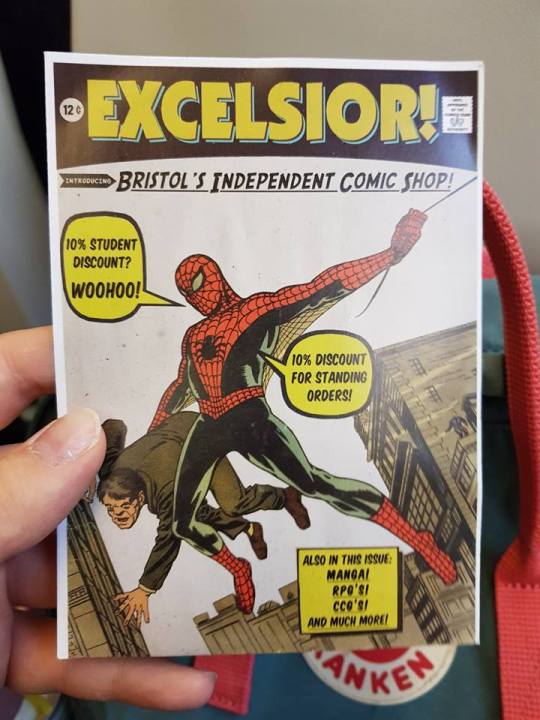
Reflecting on the time it took us to begin producing anything visual to represent our event/its branding was rather slow. Although the production began within the first week on conception in terms of the overall time frame it was actually quite stressful to think we had gone so long without it until that point. This draws on my earlier criticism about keeping to a set deadline structure and possibly putting the theme/inspiration behind the event first and thus the brief and then the brand and visual imagery/iconography first and earlier in development.
As well as the events teams beginning to come up with locations for the after party the curation team were coming up with ideas and solutions to mount and display artwork in the limited space given by our now secured location Castle Emporium. One of which was to use the resources at hand that the location provided. To have our works mounted to a professional standard but what we deduced was that this was possibly too expensive (especially with a budget limited to printing and cheap mounting), the added time restraints and lack of wriggle room for error when it comes to meeting another deadline out of our own hands and finally and what we decided the most prominent issue was not mounting and displaying the artwork ourselves; we later decided to have ourselves as individuals to provide a frame each for our already-printed and mounted (by the curation team) artworks.
If we were to tackle this issue again I believe it would be best to asses the situation further and make the most efficient and cheap decision possible when it came to mounting and displaying the pieces; either by bulk buying uniform frames or even up-cycling older frames and reworking them to fit a uniform niche. Despite this criticism I believe as team the decision we made and the result of which turned out rather decent. By sticking to simple frame of similar styles and limited colour we introduced an impressive level of character to our pieces individually and as a whole/as an exhibition.
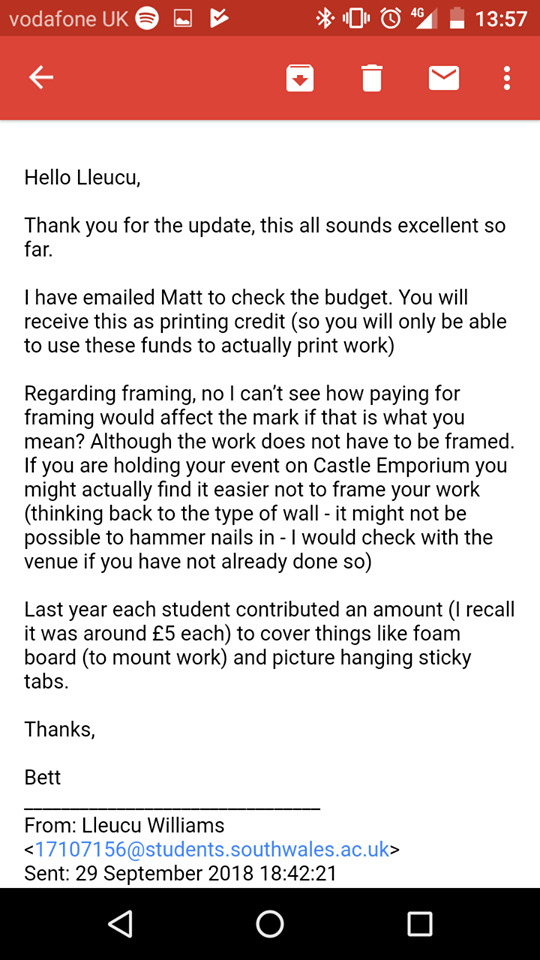
(A response email we received from Bett where we enquired about the ramifications of us outsourcing mounting our work for the exhibition)
October 3rd, 2018
By this time we were finalising the agreements with Tiny Rebel in securing their location for our after party after our private viewing held on the 13th. At this point the events team were responsible for also providing entertainment and fleshing out the after party as a whole so they had began brainstorming amongst themselves and dropping ideas in and out of the chat for context and reassurance of quality.
In amongst the discussions of the the after party we (the Location and logistics team and the curation team) decided that the day of set up would be the 12th and if any final adjustments or reconciliation is needed we still had the day time before the launch night the day after at 6/7 pm.
By this date we had the official Facebook page and very soon to follow would be the Instagram page.
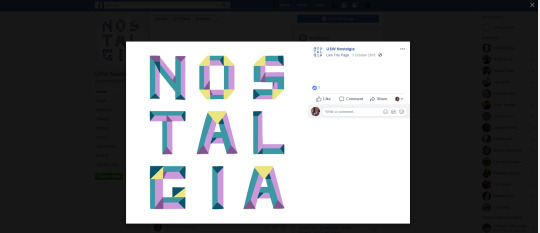
(The first post on both our Facebook and Instagram accounts announcing our project and teasing more info to come. Managed and monitored by our promotion team)

We came to many conclusions the same when it came to the visual aesthetic and language of the project.
- The design team would submit work (be it logos, poster art or illustrative imagery).
- We, as a group, would vote on polls and give constructive criticism and feedback
- The design team would either repeat this process with improved designs
or
- The promotional team would then either rework or directly post or print such media to promote the event. teasing more info and details as they did.
As the event would draw closer, the posts would gain more speed and increase in information and “hype” as well as the frequency of posts increasing to create more buzz.
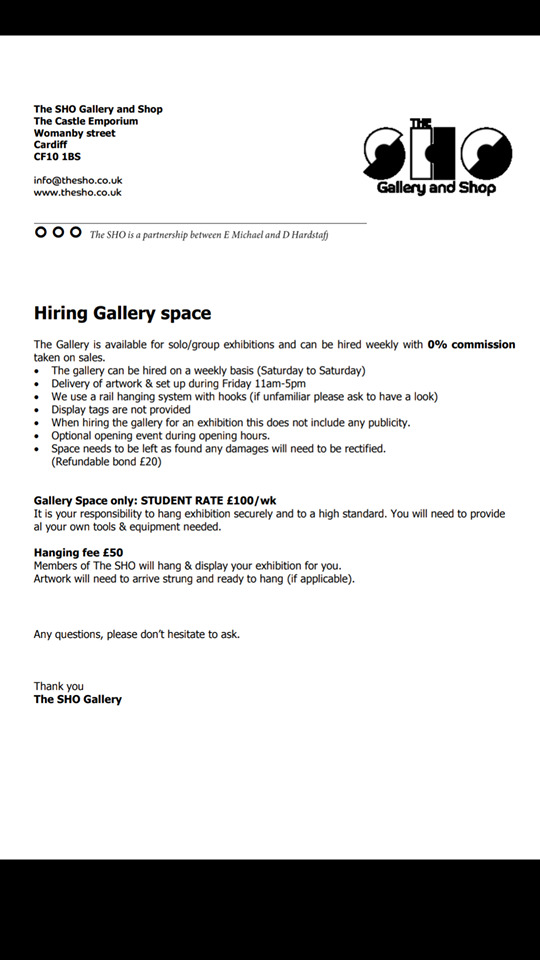
(Above is the standard Sho Gallery invoice I asked for and received personally from Emily the owner of the gallery space)

(Above is the invoice we received from Emily once we had finalised the dates and cost etc)
With the deadline for the artwork creeping ever closer there seemed to be a real pressure on the promotional team. They were very much at the mercy of everyone, not only, meeting the deadline for their final artwork but receiving enough artwork leading up to the event to “tease” to our audience and getting provided with enough content from the design and branding team to keep them in work with creating digital buzz and physically printing promotional material.
As time grew thinner they seemed to get more stressed and agitated but they still remained strong and persevered throughout all the shortcomings of the design and branding team.
If I was able to re-do this portion of the project and perhaps be in full control, i feel i would take inspiration of my previous critique. Enforcing a stricter regime of deadlines and demanding more “work in progress” or “process” pieces from the students involved as well as the expected design and branding team. In effort to provide the promotional team with enough material to create the promotions and advertisement media they desired/needed. Its a very disheartening feeling to feel like you're giving everything you can within a group project and to either feel weighed down my slacking members or worse feel stunted by their lack of consideration or genuine ignorance.
Once we had fully secured, agreed upon the details and exchanged the invoices it was time to discuss the payment method. This was fairly straightforward and there were no qualms in amongst the group. we each payed and even share of a small amount to secure our events locations and that was it. During this period Elena, Lleucu and myself were in constant contact to ensure the payments were going through and everything was being executed flawlessly, and it was, and it did. Thankfully.
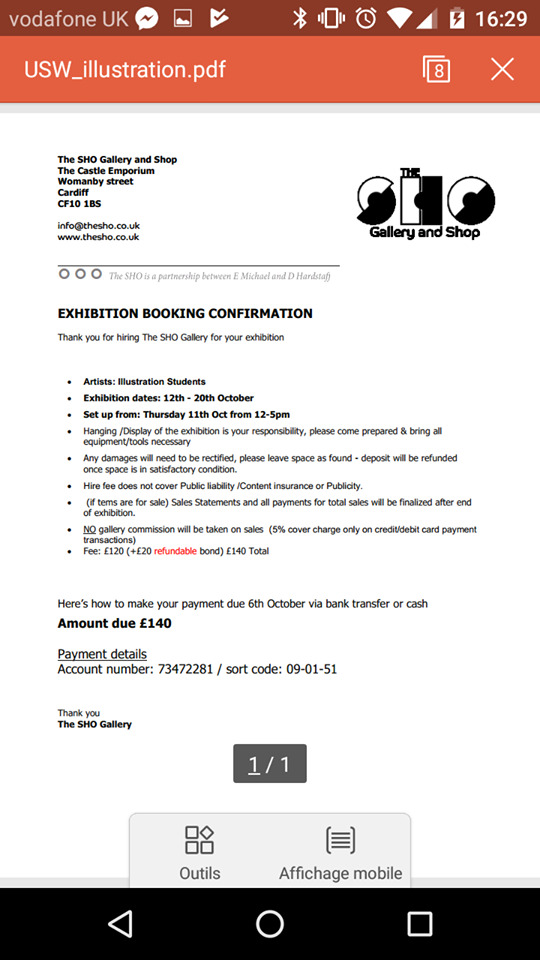
(Above our confirmation of booking)
October 4th, 2018
Over the final weekend before our exhibition there was a gargantuan push amongst our group for WIPs and completed pieces (as stated before) to aid in the promotional material put out by the promotion team.
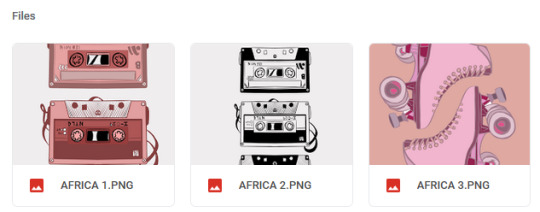
(Above some designs we had a choice of that had been uploaded using our google drive account open to all the group members)
Around this time me managed to set up our Facebook event. I’ll be linking the Facebook page below so you can have a look at how we proceeded from this time going forward with our exhibition and overall project.
https://www.facebook.com/uswnostalgia/
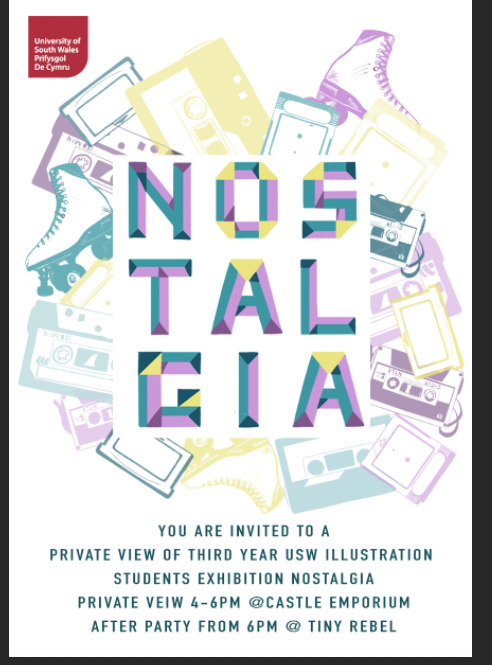
(These two images were some of the earliest concepts for the promotional artwork and would later go onto print)

We decided to make it bilingual to not only add maturity to the project/event and as well as pay homage to USW as a whole but we had fluent welsh speakers in amongst our ranks and we thought to use everyone's skills to the best of the groups ability.
The next big step we were taking was to do with the curation and promotional team again. Our group began printing physical promotional material with the help of our groups USW granted budget.
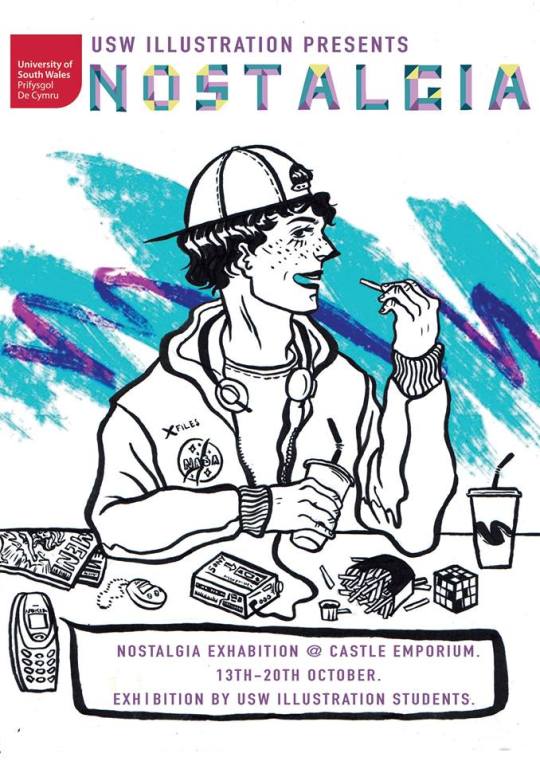
(Some promotional material featuring Asia and Rachel’s artwork from the design team)
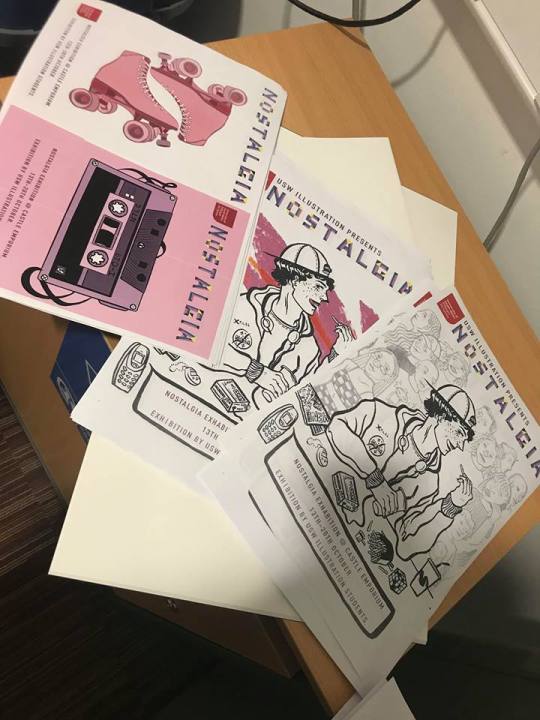
As for what i may have done differently with the printed promotional material would simply have tried to put it our sooner and possibly expanded the reach other the posters and flyers by giving ourselves more time to spread them throughout Cardiff and the town centre.
What i do like about the material though is that it heavily promotes the artwork of the exhibit and the themes and colour pallets are definitely on brand.
The curation teams job of setting up the exhibition space was drawing closer and so was the tasks that came with it. One of which was, in addition to our individual pieces of work, were the artist cards that displayed our names, and networking information as well as some whimsical or insightful meaning behind our artwork; their nostalgic muse.
To make this as simple as they could the team create a label template (as seen below).
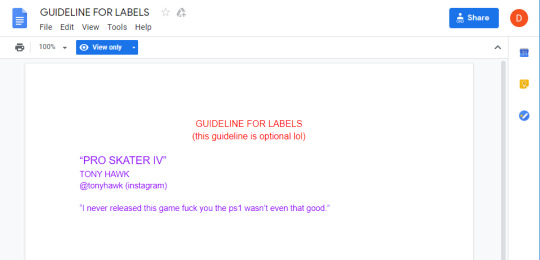
(Below some more promotional material, this time used for flyers)
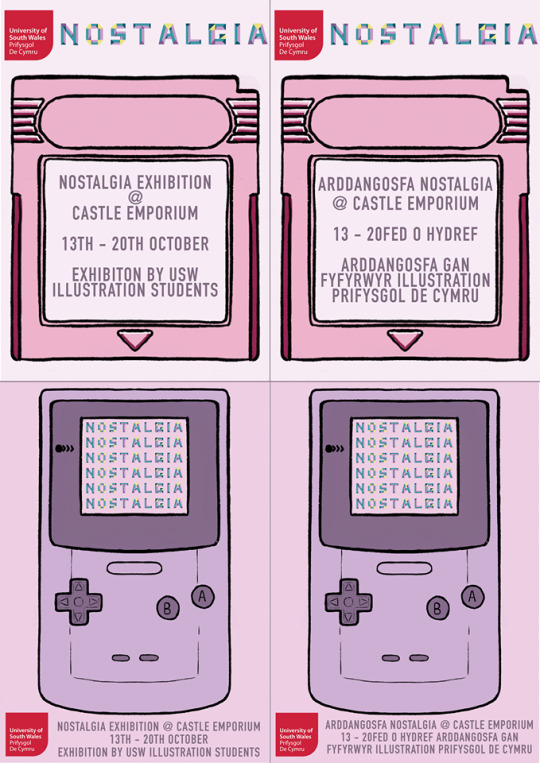
October 9th, 2018
Freya and the rest of the curation team, including some others from other roles met up to begin the printing an mounting process of the exhibition art pieces. During this time we had agreed, via the curation team’s advice, to supply our individual frames on this day as well so the mounting AND framing processes were complete at the same time to save hassle later and avoid any unwanted mishaps before the final set-ups came about.
Looking back this was very well planned out by these particular groups and although agree upon and followed up with successfully by everyone else in the group, I can safely say this was one of the smoothest processes to have occurred during this entire project and I thoroughly believe that all boiled down to precise planning and the brilliant execution of the roles involved. We could not fault them.
October 11th, 2018
Up until this point majority of the teams had been fulfilling their required roles. Events had been networking with local businesses and getting our posters/flyers into their stores.
The curation and logistics teams had begun to transport all artwork and supplies to the exhibits location.
Finally the promotional teams were successfully created an tangible atmosphere of excitement with their posts and constant updates via leaks and countdown posts. Another great thing to point out is that of their own accord they decided to tag and link all respective artists to their leaking artwork and in return our group was mass sharing the posts creating some organic symmetry between us all and the event.

(Above the USW Nostalgia Exhibition Instagram feed displaying the countdown posts and the sneak peeks/leaks of the artwork to be displayed)
The refreshments for the launch night were arranged to picked up the day of and the promotional and events roles teamed up with the idea of holding a competition draw, the prize being art prints, hand crafted items and other “goodies” to announced on the night etc.
A great way to add another level of thought and depth to the event.
October 12th, 2018
The curation team planned on meeting around noon-3 pm this day to prepare the exhibition and have plenty of time to adjust compositions and displays beforehand.
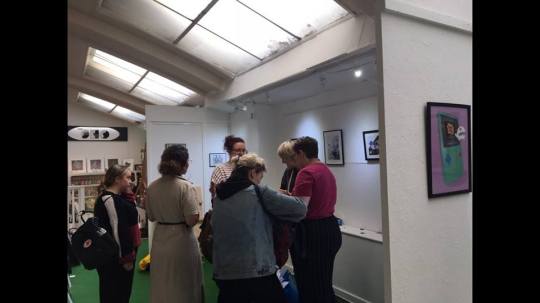
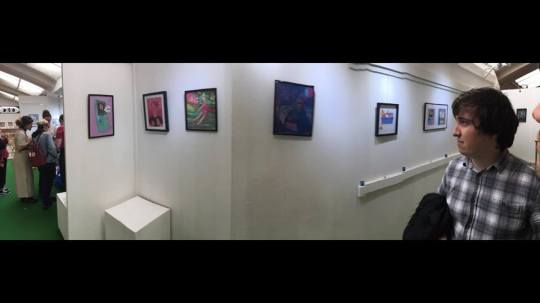
(Above some shots of the exhibition space just after the pieces had been set up, before the private launch day)
0 notes
Text
Remarks of FASB Member R. Harold Schroeder, ThinkBIG 2019 Conference, Orlando, FL
Opening Remarks of FASB Member Hal Schroeder (as prepared for delivery) ThinkBig 2019 Conference “Roadmap to the Future: Fact vs Fiction (on CECL and Other FASB Standards)” Orlando, Florida September 26, 2019
Back in the spring—as the school year was ending—I showed my daughter a picture of what appeared to be an old, very thick textbook. Knowing the last thing she wanted was another textbook, I jokingly told her we were going to buy it. She then asked two logical questions: Why? and How much?
I won’t get the tone of her questions quite right, so I’ll just say there was a lot of eye rolling. Now, in my defense: She had no facts, she didn’t know the book’s history. Without any historical context, without opening the book to see its contents, she couldn’t appreciate the importance of this book.
What she saw was the tattered, brown-paper cover; blank, except for three handwritten letters. So, she was shocked to learn what it would likely fetch at auction.
The book was Luca Pacioli’s
Summa de Arithmetica
. In the press release
1
announcing the auction, Christie’s noted its broad-ranging contents: “from double-entry bookkeeping to probability theory and computing, the mathematical principles of the most vital features of contemporary finance are all present.” In other words, this 525-year-old tome is the “first practical how-to book on succeeding in business.”
During a multi-city tour, Christie’s invited the FASB to experience the book firsthand. As the curator opened the cover to read passages and to highlight various illustrations, I developed a deeper understanding of what was inside the book, why it was important, and how it was constructed. No wonder this book has stood the test of time.
I tell this story because it’s a great example of the idiom: You can’t judge a book by its cover. The same can be said for the FASB’s projects I’ll talk about today. And, for our stakeholders—particularly preparers and auditors—it’s imperative that you get past the cover of each new standard in order to distinguish fact from fiction; what’s changed and why.
Hence, the title of my presentation
Roadmap to the Future: Fact versus Fiction
. So, today I’ll provide some facts about what we’ve been doing since issuing CECL in 2016. And, I’ll try to separate fact from fiction by laying out what we hear.
*****************
Before going any further, I must first remind you of the standard disclosure: Official positions of the FASB are reached only after extensive due process and deliberations. In other words, what I am about to say are my views and only my views.
The standard disclosure I just read appropriately puts an emphasis on the FASB’s “process” for setting accounting standards. And, that’s where I’ll start.
About the FASB
Last year alone, Board members and staff spoke at 156 events nationwide and hosted 575 liaison, advisory group, and project outreach meetings.
2 The People
At one such meeting a few years ago, a group of community bankers came to visit us in Norwalk, CT. A CEO—from a small town near to where I grew up—told us he’d been at a Rotary Club lunch the day before. He said someone at his table was surprised to learn he was going to meet real people at the FASB. I asked him to please reassure the folks back home, we are real people! So, to provide some perspective on the FASB process, it helps to first understand the people; both the Board members and staff.
Speaking for myself, the comments I make today—as well as my votes at the Board table—are informed by four decades of experiences: as an auditor and advisor to a wide range of financial services companies—from the largest global entities to the smallest community banks in south Louisiana; as a CFO; as both an individual and institutional investor; as a manager and owner of private businesses; and, now, as a member of the FASB in my second and final term. (Yes, we have term limits.)
Combine my experiences with those of my fellow Board members and staff, and you begin to see a wide array of experiences and multiple perspectives. This diversity of views is by design. Think of it this way: If any two Board members always agree, one of them is redundant. Now, add to the mix the boots-on-the-ground experiences and perspectives of our advisory groups and stakeholders like yourselves—that participate in our outreach meetings—and it’s clear that the process of setting accounting standards is not done in a vacuum or an ivory tower.
The Process
The Board and staff often talk about the standard-setting process, up to the point of issuing a new standard. We don’t talk as much about the equally important post-issuance phase. Once a major new standard is issued, we spend the time—often years before its effective date—educating stakeholders and monitoring company implementation efforts.
One reason we do this is to re-confirm that a new standard’s wording is understandable, operable, and auditable. Another is, we want to ensure it will stand the test of time.
During numerous education and monitoring sessions—based solely on the questions and comments of the participants—it becomes readily apparent who’s gone past the cover and is deep into implementing a new standard. And, equally apparent, who hasn’t broken the book’s binding.
With the latter group, we often find ourselves reiterating and relitigating a range of questions. Personally, I enjoy the debates. However, most of their questions have already been asked and answered in the due-process documents and final standards issued in accordance with the FASB’s Rules of Procedure.
3 Addressing What & How
As much as I enjoy the debates, I’ll simply highlight a few points about what’s required and how to do it.
Regarding the “what” of CECL specifically—in the past year the staff has received very few questions, many of which could be quickly answered by referring directly to the guidance. Considering that our technical inquiry service is free and accessible online,
4
the limited number of questions is at odds with the view—some have voiced—that there are many unanswered questions and, therefore, CECL should be delayed.
For other more-involved questions, we’ve made targeted improvements to enhance understandability and operability. Answers to those questions can be found at our CECL implementation portal.
5
Regarding “how,” we’re committed to looking for ways to ease transition efforts. For example, in January, we published a Staff Q&A about using WARM
6
(weighted-average remaining maturity), which is an estimation method already familiar to many smaller financial institutions. It was followed in July by another that addresses developing estimates
7
by responding to 16 frequently asked questions about:
using historical loss information,
developing reasonable and supportable forecasts, and
applying the reversion to historical loss information.
Both Q&As are part of the Board's continuing commitment to educate stakeholders.
They cover common questions we’ve heard during the last three years at various post-issuance educational sessions—the same questions covered in numerous PowerPoint presentations we’ve delivered. So, the Staff Q&As are a more formalized version of what we’ve been saying.
In addition to those Q&As, the staff are hosting several implementation workshops around the country. Again, please check our CECL implementation portal for dates and locations.
Assessing Costs & Benefits
And, despite some very public comments to the contrary, a thorough cost-benefit assessment of CECL was conducted—as is done on all standards in accordance with our Rules of Procedure. We explain why we came to our decisions in the “Background Information and Basis for Conclusions” section of the standard. A summary
8
of the assessment is also provided on our CECL implementation portal.
Disciplined Process
In my now over eight years on the Board, I’ve come to appreciate the high-quality standards that result from its disciplined process. CECL may not be perfect, but it’s a vast improvement over the status quo. And, we’re doing everything we can to support your success.
So, I have a request: When you hear someone say the FASB didn’t follow its due process, please ask if they’ve gotten past the cover, past the headlines in media reports. Have they read the standard, in particular, the basis for conclusions?
Like any classic book, standards such as CECL should be read multiple times. The same is true for the Staff Q&As. With each subsequent reading, new insights are gained, leading to greater benefits and a more cost-effective implementation.
Final thought on process: disagreeing with a Board position is fine. I certainly have, in fact, about 10% of the time—just read any one of my dissents. But I’m troubled by those that make public statements, unsupported by the public record documenting the process.
Calls to “Stop and Study” During the Past Year
Despite years of discussions and debates, there continue to be efforts to relitigate CECL. As you may have heard or read, reconsideration of CECL was the focus of a roundtable meeting this time last year. It was hosted by three congressmen to facilitate a discussion of a “regional bank proposal.”
A few months later, a modified version of that proposal was formally submitted to the FASB. Again, following established process, the FASB staff held dozens of meetings that included financial and nonfinancial entities, as well as other stakeholders.
The views heard in those meetings were very consistent with stakeholder comments at a public roundtable we hosted in January—splitting the provision, with a portion flowing through net income and the remainder in OCI, was not operational. This was not a surprise. Banks—large and small—had provided the same feedback in 2013, when the Board had explored the same idea and its many variants.
We also heard from investors that, if the provision is split, they would need additional disclosures. However, those re-proposing a split did not support expanded disclosures. After hearing all sides, and consistent with its 2013 decision, in April the Board again voted to not move forward with any requirement to split the provision.
On the Regulatory and Legislative Fronts
In October 2018, a trade associations' letter
9
was sent to the chair of the Financial Stability Oversight Council
10
(or FSOC). Voicing concerns about CECL, the letter recommended that FSOC “seek a delay in implementation until such a study can be completed.”
As a refresher, FSOC is an interagency body consisting of ten voting members—those being the principles of the federal agencies that regulate the U.S. financial services industry—and five non-voting members—those representing various state authorities.
11
And, it’s chaired by the Secretary of the Treasury.
At FSOC’s December 2018 meeting, there was a discussion of CECL. In reading the publicly available minutes
12
you see mention of the “extensive work undertaken by the FASB, including publicly issuing proposals in 2010, 2011, and 2013, prior to adoption of CECL in 2016.” The discussion was led by the Comptroller of the Currency, who stated that “the OCC believes CECL is an improvement over the incurred-loss accounting model.”
With no reduction in regulatory capital imminent, the “stop-and-study” movement is now seeking a “legislative fix” with bills proposed in both the House
13
and the Senate.
14
However, it’s worth noting that in separate actions, study-only directives have been attached to both House
15
and Senate
16
appropriations bills. The requests are directed toward others including the SEC and the U.S. Treasury, but not to the FASB. The Senate action specifically directs the Treasury, in consultation with the federal bank regulators, to “conduct a study on the need, if any, for changes to regulatory capital requirements necessitated by CECL, and to submit the study to the Committee within 270 days of the date of enactment of this act.” Note that this study will assess the need for a change to regulatory capital; not to CECL.
My views? Those in the audience that know me won’t be surprised. I do have views on the matter. But as a reminder, these are my views and should not be interpreted as the Board’s views.
Calls for Quantitative Impact Study
“Stop-and-study” efforts call on the FASB to perform an economic or quantitative impact study on CECL. (Going retro, I’ve heard it called “delay-and-pray,” mimicking the approach used by some to deal with problem loans in past banking crises.) Those advocating stop-and-study allege dire consequences from CECL’s so-called procyclical effects on lending. However, independent studies
17
already conducted do not support such concerns.
Consider data contained in a recent study
18
published as a working paper in the Federal Reserve’s
Finance and Economics Discussion Series
(or FEDS). The study, and I quote, “shows that a disproportionate share of the associated provision expenses occurs prior to the recession under CECL, rather than during it.”
The study quantifies CECL’s earlier provisioning, estimating that “roughly 62% of the trough to peak increase in allowances occurs prior to the recession [compared to] only 11%” under the incurred loss model.
Now, combine that finding with other independent studies showing banks that provision earlier are better positioned to lend in an economic downturn.
Quoting from one such study: “Consistent with the pro-cyclical provisioning hypothesis we observe a greater reduction in lending during recessions by banks that delay expected loss recognition more compared with banks that delay less.”
19
That conclusion was based on 24,788 bank quarters of data, stretching over a 16-year period (1993 to 2009) that included 2 U.S. recessions. Another study,
20
based on 3,091 bank-year observations, across 27 countries over 11 years (1995 to 2006), yielded complementary results.
Yet, I expect critics will point to the FEDS working paper to show that CECL reserves would go up during a recession and would be higher than under the incurred model. I agree with the observation. CECL allowances would likely increase during a recession and peak at a higher point.
In fact, using the same data, I calculate
21
CECL-based allowances would have increased an estimated 29% from the beginning of the recession and peaked in the fifth quarter. However, those same critics are unlikely to mention that under the incurred model, allowances actually increased 264% during the last recession—8 times that expected under CECL—and, didn’t peak until the ninth quarter—taking almost twice as long to recognize losses.
Bottom line: As independent studies show, banks that are better reserved heading into a recession are better positioned to lend during a recession. And, it is the banks that reserve later, and take longer to work through existing losses, that cut lending during a recession.
Therefore, I believe concerns about CECL’s impact on lending are misplaced.
Studies—Yes, Stop—No
My comments today should not be interpreted to mean I’m anti-study. In fact, just the opposite. I believe well-designed, well-executed independent studies—a few of which I’ve cited—are an invaluable tool to standard setting. And I believe there should be more in the future, using real data as it becomes available.
What I’m opposed to is stopping CECL’s implementation. Here are a few reasons why.
No Change to Cash Flows
A key point to remember, under CECL: a good loan will still be a good loan; a bad loan will still be a bad one. This is because CECL doesn’t—in fact, it can’t—change the ultimate cash flows or a borrower’s ability to repay. And CECL doesn’t even change when to charge off a loan. It changes only the timing of when loss provisions are recognized in net income and, in turn, reserves built on the balance sheet.
Greater Transparency
Even absent CECL, investors are and will be making their own estimates of expected losses. Speaking with firsthand knowledge, investors began ignoring GAAP allowances—effectively making their own, much-higher loss estimates—18 months before the beginning of the last recession. This is in stark contrast with the fact that GAAP-based allowances didn’t hit bottom—a multi-decade bottom—until just 12 months before the recession began.
What CECL does is provide greater transparency into changing credit risk. Instead of having to rely solely on their own estimates, investors and other users will be able to start their analyses with managements’ more-informed estimates.
If there’s any doubt in my view: In the last few months, I’ve been talking with investors. What some have shared is that they’re already beginning to again ignore GAAP provisions and allowances and, to again, make their own loss estimates. As Mark Twain is often credited with saying: “History never repeats itself, but it rhymes.”
So, how do we reconcile the clear need for better alignment between accounting and changes in risk, with calls to stop a standard that provides much-needed transparency? I can’t.
On a Personal Note
. . .
In my former job as a portfolio manager, I’d have been okay with keeping opaque accounting. Frankly speaking, our investors earned better returns because we were estimating expected losses. It gave us a competitive advantage.
But as a member of the FASB, I’m
not
okay with the status quo. No competitive advantage is worth keeping accounting that:
In “good times” masks warning signs of rising credit risk, and
In “bad times” is ignored.
Effective Dates for Private and Smaller Public Companies
At this point, you may be asking: If he’s so pro-CECL, why does he support delaying its effective date? As a reminder, the Board is tentatively scheduled to vote on this matter at its October 16
th
meeting. So, you should know before the yearend holidays whether and who will get a delay in applying CECL.
I support a delay because some of you in this room made a compelling case—and our research confirmed—that implementation challenges are often magnified for private companies, smaller public companies, and not-for-profit organizations. Access to resources, education, and technology varies considerably among organizations of different sizes.
We did not want those hurdles to block the path toward a successful implementation for anyone.
We also observed that when it comes to applying standards, private and smaller public companies can learn a lot from the experiences of larger public entities. More time between effective dates means more time to learn.
It’s also worth noting a practical implication—roughly 90% of financial services companies (by number) would get extra time to adopt the standard. However, I don’t believe investors will be significantly affected, because the 10% that won’t get extra time represent 90-ish% of the industry assets.
But I wouldn’t be surprised to see some entities that could take more time, elect to early adopt—which I expect will be permitted.
Not All Smaller Institutions Agree
I say this because, minutes before an August vote, a community bank CEO called me to express his strong disagreement. He said his bank didn’t need the additional time.
It was not the first time the two of us had debated various aspects of CECL. We’ve had numerous discussions; the same as with other bankers. So, at a high level I shared with him what I’d heard. It was a good rehearsal for what I was going to say at the Board table in just a few minutes: When implementing major standards, such as CECL, it’s more cost effective to take an integrated, wholistic approach that coordinates accounting changes with other changes needed to run a successful business—what I refer to as a “business approach”—which contrasts with treating accounting changes as simply a “compliance exercise”—incurring costs with minimal to no benefits for running a business.
I believe providing an opportunity to take a business approach is the strongest, most compelling argument for extra time.
Benefits to Taking a Business Approach
In fact, as we monitor progress among larger lending institutions—those preparing to implement CECL next year—we’ve observed the benefits. In private meetings—including a few where we’ve had to sign non-disclosure agreements—we’ve been told that the effort to adopt CECL has resulted in widespread improvement of data quality, internal controls, estimation processes, and internal coordination and communication.
A few bankers have gone even further, saying that they expect additional improvements will be achieved over time. Think of it as a virtuous—some say vicious—circle. More and better data leads to improved estimation processes. Those processes benefit from technology advances, such as faster processing speeds and more memory. Advances in technology facilitate the use of more and better data that improves estimation processes . . . and the cycle continues.
As a banker told me, “Improvements were needed; CECL simply accelerated the timing.”
One Cautionary Note
Now that the Board has voted to provide the 90% with extra time, I believe there’ll be an even greater expectation for high-quality implementation efforts.
Don’t look at it as an extra year off. Treat it as an opportunity to improve your data quality, estimation processes, and internal controls. Start now. If you’ve yet to break the book’s binding, do it today.
Reference Rate Reform
Now, on to another issue—one that likely affects everyone in this room: reference rate reform. This is a global issue driven by market forces, not the FASB.
What Is Reference Rate Reform?
The London Interbank Offered Rate, or LIBOR, is expected to be phased out in 2021. Globally, there’s an estimated $350 trillion of financial instruments—over half of which is in the U.S.—that reference LIBOR
22
including, for example, adjustable-rate mortgages.
Efforts are under way (1) to identify risk-free alternative rates to replace IBORs and (2) to develop transition plans that support reference rate reform. Those industry-led efforts are focused on tying benchmark rates to observable, arm’s-length transactions.
In July, the SEC issued a public statement
23
noting that the transition away from LIBOR could have “a significant impact on the financial markets and may present a material risk for certain market participants.”
Addressing Accounting Obstacles
Reference rate reform has been a major priority for the FASB. We’re proactively addressing accounting obstacles that could hinder smooth transition.
Simplifying Accounting Evaluations.
And earlier this month, we issued a proposal that would make it easier to transition contracts and other arrangements to a new reference rate.
First, we proposed to simplify the accounting evaluation of a contract modification. For a contract that meets certain criteria, the change in its reference rate would be accounted for as a continuation of that contract, instead of the creation of a new contract.
We also proposed to simplify the assessment of hedge effectiveness—and to allow hedging relationships affected by reference rate reform to continue.
Optional and Temporary.
Application of this relief would be optional. We think it will minimize the disruption of reference rate reform on financial reporting and provide users with more useful information.
Companies and other organizations that elect to apply the guidance would do so prospectively—in other words, the new guidance could be elected for contract modifications and hedge evaluations that occur after we issue the final standard.
The guidance would be temporary, expiring on January 1, 2023. To my knowledge, if finalized, this would be the first time we’ve ever issued an accounting standard with a “sunset provision.”
Looking Ahead
The comment period on this proposal is open until October 7th. I encourage you to review it and get your comments to us as soon as possible. As always, your insights will help us develop a better standard.
**************
Closing Remarks
Before concluding, I want to thank you for your engagement in our process.
We may not always agree on outcomes. But we will always engage in the conversation. And we will work with you to help ensure a successful transition to our standards.
And now, I’m ready to take your questions.
10
As stated on the FSOC website, “The Financial Stability Oversight Council has a clear statutory mandate that creates for the first time collective accountability for identifying risks and responding to emerging threats to financial stability. It is a collaborative body chaired by the Secretary of the Treasury that brings together the expertise of the federal financial regulators, an independent insurance expert appointed by the President, and state regulators.”
https://www.treasury.gov/initiatives/fsoc/about/Pages/default.aspx
14
S.1564 - Continued Encouragement for Consumer Lending Act,
https://www.congress.gov/bill/116th-congress/senate-bill/1564 15
116TH Congress, 1st Session, House Report 116–122, “The Committee directs the SEC, in consultation with the Federal Reserve, the FDIC, the Office of the Comptroller of the Currency, and NCUA, to conduct a study of the potential impact of the CECL accounting standard issued by the Financial Accounting Standards Board (FASB) and provide the study to the Committee, and to the Financial Services Committee, within 180 days of the enactment of this Act. The study shall address the impact of the CECL standard on credit availability, costs to consumers, and overall stability of the banking sector, and assess whether the FASB employed sound economic analysis and modeling.”
https://www.congress.gov/congressional-report/116th-congress/house-report/122/1?overview=closed
17
Refers to comprehensive studies conducted by researchers not associated with individual banks or trade associations.
18
Loudis, Bert, and Ben Ranish (2019). CECL and the Credit Cycle," Finance and Economics Discussion Series 2019-061. Washington: Board of Governors of the Federal Reserve System,
https://doi.org/10.17016/FEDS.2019.061
.
19
Beatty, Anne, and Scott Liao. 2011. “Do Delays in Expected Loss Recognition Affect Banks’ Willingness to Lend?”
Journal of Accounting and Economics
52: 1-20.
20
Bushman, Robert M., and Christopher D. Williams. 2012. “Accounting Discretion, Loan Loss Provisioning, and Discipline of Banks’ Risk-Taking,”
Journal of Accounting and Economics
54: 1-18.
Printable PDF
republished from FASB - Latest News
0 notes
Text
Be a Better Teacher and Writer: 6 Teaching Techniques You Should Know
Marketing is a chance for education.
Sometimes, marketing takes the form of entertainment, but often, you get to assume the role of a teacher.
This is really powerful. You can become one of the few educational influences in most people’s lives after they leave school.
Beyond helping your business grow, inbound marketing allows you to make a real impact.
Partly, that’s why I’m still so passionate about it even after all these years.
Once you start thinking of yourself as an educator, you can become an even better marketer by learning from traditional teachers.
I’m going to show you 6 different teaching techniques you can use to make your marketing content even more useful to your readers.
1. Use the “desire” method
You might already be using this method even if it’s not intentional.
The “desire” method is all about getting students’ attention.
Think of an average class, even at the university or college level. Most students don’t want to be there.
They feel like they’re learning something that probably won’t be very useful and just want to know what’s on the exam so that they can pass it.
One of the main reasons for this is because lectures are set up to teach about a topic, not to satisfy a desire.
For example, in a computer science course, you might have a lecture about sorting algorithms or asymptotic complexity.
Even if you have an interest in computer science, those titles alone won’t get you excited about learning.
What happens in the first few minutes of those lectures?
More or less the same thing every time. It’s usually a slide about “what you will learn,” which again just lists the specific things included in that topic.
The solution is to build desire: What if you started off with the benefits of learning the topic?
Back to our example about asymptotic complexity, which basically just classifies how fast an algorithm can run (how complex it is).
What if, as a teacher, instead of saying that your students will hear a lecture on “asymptotic complexity,” you say that they will learn how to “find inefficiencies in code and speed up their applications.”
That’s already more attractive and speaks to what students really want to learn.
The intro slides could focus on how coders at Google use the concept of asymptotic complexity in their daily work. Or how a long-time coding problem was solved because someone found a way to reduce the complexity of the coding solution.
Using the desire method in your content: This concept is all about focusing on benefits to readers and customers. More so, it’s about conveying those benefits in the headline and at the beginning of any content.
While many marketers don’t know why they do it, this is the reason why having a benefit-driven headline is so important. If you’re teaching something that will help your reader accomplish something, make it clear!
In addition, your introduction is your chance to show your reader what could be possible if they learned what you are about to teach. Cite statistics, case studies, personal experiences, and anything else that shows how great the results can be.
2. Games are more fun than work
Ask anyone whether they’d rather read a textbook or played a video game, and you’ll get the same answer 99% of the time.
Educators have realized that students learn better if they are fully engrossed in a lesson, which happens if they are having fun.
That’s where the concept of “gamification” came from.
No, you don’t have to create a video game for your content, but there are ways to make your content more game-like and fun for readers.
Let’s look at a few ways you could do this.
Example #1 – Quizzes can be fun: A quiz can be either fun or boring, depending on the topic.
Online quizzes draw engagement and grow in popularity when done right—that’s a fact. A study of 100 million articles in 2013-2014 found that 80% of the most popular pieces of content were quizzes.
For example, the top one was: “What Career Should You Actually Have?”:
By framing it around fun careers (Oprah on the intro image), the creators drew people to the quiz.
When you create a piece of content, consider designing a quiz to go with it.
There are many free tools, such as Qzzr, that you can use to create a quiz. You just copy and paste the HTML code that it gives you into your content:
If you use WordPress, you could try the SlickQuiz plugin, which allows you to create quizzes from inside your admin panel:
Another benefit of using quizzes is that most people who take them will consider sharing their results with friends, bringing you additional traffic.
Most quiz tools include social sharing buttons on the results screen to encourage sharing.
Example #2 – The M&M’s pretzel scavenger hunt: This was a fun but simple game that M&M’s made in 2013.
The whole came consisted of one simple picture in a Facebook post.
The objective was to find the hidden pretzel man in the image. Even without getting any prize, Facebook users loved the simple game and shared it with their friends.
This game resulted in 25,000 new likes on the product’s Facebook page plus over 10,000 comments and 6,000 shares.
Example #3 – How Heineken successfully used an Instagram game: During one of the biggest events in tennis, the 2013 US Open, Heineken created an Instagram account.
A new account was loaded with 225 pictures of people in tennis audiences.
To win the game, you had to follow clues in the pictures that led you to the final picture.
It was essentially a complicated scavenger hunt.
This game lasted only 3 days, but Heineken increased its follower count by 20%.
3. Start with pain
This tactic goes well with the desire method (from #1 above).
People are motivated in two main ways:
To get benefits
To avoid pain
It’s natural to want to get good things and avoid bad ones.
Focusing on inducing desire was about the benefits. It’s achieved through showing what learning about your topic will do for your reader.
Here, though, you want to drill home what will happen if they don’t learn from your content.
For example, if you write a guide to correct posture, you could point out that if the readers don’t learn from your guide, they may develop poor posture, accompanied by back and neck pain and chronic discomfort.
Desire and pain can be used together, or they can be used separately.
Here are a few headlines that focus on benefits:
4 Ways to Boost the Conversion Rates of Your Link Building
5 Ways to Make Your Content Mobile-Friendly for Increased Traffic and Engagement
Here are a few that focus on pain:
7 Warning Signs Your Free WordPress Theme Is Sabotaging Your Blog
Don’t Get Left Behind: The 8 Most Effective Link Building Tactics For 2015
The same goes with your introduction. Pain, especially if the reader is already aware of it, is a great way to get their full attention.
If you illustrate the pain well, readers will pay close attention to your work, which will result in better learning.
4. Chunking works wonders
There’s more to teaching than just getting the attention of your students.
You also want to teach your material in a way that maximizes how well a student learns as well as remembers what you taught.
That’s where chunking comes in:
Chunking involves breaking up a complex topic into smaller “chunks.” Studies have shown that this improves short-term memory retention.
The classic example is phone numbers.
Most phone numbers consist of 10 individual numbers, for example: 2338223948.
If someone just read out those numbers, they’d be hard to remember. However, if you separate them into three chunks, it gets a lot easier: 233-822-3948.
Applying chunking to content: The main principle behind chunking is breaking down something tough to learn into smaller bits.
When it comes to content, you can use that in two ways.
First, divide up your content into smaller subsections by using subheadlines.
If you look through any of my posts, you’ll notice that I have subheadlines every 200-300 words.
While there’s no specific length you need to aim for, make sure the subsections don’t get too long. If they do get long, break them up again into further subsections (usually h3 or h4 tags).
Next, you can apply chunking to paragraphs. It’s hard to focus and learn reading long paragraphs.
You should have 2-3 sentences per paragraph maximum in almost all situations. You can see that I have short paragraphs like this one in all the content I create.
This is a simple change that makes a big difference.
5. Understand and use VAK
Something that educators need to understand is that not everyone learns the same way.
One popular viewpoint is “VAK,” which stands for visual, auditory, and kinesthetic. Or in regular terms: seeing, hearing, and touching.
Different people learn best in different ways. Some need to touch things to learn, while others prefer seeing.
However, the vast majority of people learn best when more than one (or all three) ways of receiving information are involved.
To illustrate this concept, let’s go through an example.
Pretend you were teaching how to pump up a basketball. Here are examples of different ways to teach it:
Visual: Write a blog post on how to pump up a ball; you could include pictures. Or create an infographic, detailing the process.
Auditory: Create an mp3 recording explaining the steps.
Kinesthetic: Give a student a deflated ball and pump, and explain how to pump it up (would also include a visual or auditory explanation).
Visual+Auditory: Create a video that shows you pumping up a ball and explaining how to do it.
As you can see, there are multiple ways you can teach a topic for each learning type.
In addition, you could create multiple forms of content for a single topic. For example, you could create a podcast narration of a blog post so that your audience could both read (visual) and hear it (auditory).
The takeaway here is to try to involve multiple ways of learning for all your content. If you can get your audience to take action (i.e., go find a ball to work on), you can involve kinesthetic learning as well.
6. Engagement leads to knowledge
Many studies have shown that the more engaged students are, the better they learn.
The term engagement covers a bunch of different concepts, but it usually refers to any time when a student is actively doing something while learning. Examples would be things like asking questions, talking productively with peers, thinking, and answering quizzes.
While some of the other techniques we’ve looked at are difficult to apply online, improving engagement is very possible—not only in your content but in other areas of marketing like social media and email.
For example, we’ve already looked at including quizzes in content, which is an opportunity for students to engage.
Additionally, you can change how you write content and the type of content you write in order to get more engagement.
Here are some other guides that dig into this topic in more detail:
7 Psychological Principles to Get More Engagement on Social Media
How to Cut Your Bounce Rate in Half with Interactive Content
5 Engagement Metrics That’ll Help Improve Your Search Rankings
Conclusion
Being a teacher is a big responsibility, especially online, where you could be teaching thousands with your content.
By using the proven teaching techniques described in this post, you can help your readers learn better and take more action.
Ultimately, you’ll make a bigger impact, which will also benefit your own business.
Many of these techniques can be combined, so use any or all of them—whatever applies to your content.
http://www.quicksprout.com/teaching-techniques-you-should-know/ Read more here - http://review-and-bonuss.blogspot.com/2019/03/be-better-teacher-and-writer-6-teaching.html
0 notes
Text
FMP PROPOSAL
Section 1: Review (approx.150 words).
Over the past week, I feel like I have achieved many skills in this course. I have used many different techniques to have a unique outcome. I have experimented with varied materials such as diverse types of metal (copper), acrylic, soil, rocks, wood etc. I think that I have improved throughout the past seven units. At the beginning of this course, I was quite uneasy as I thought I was unable to create work that wasn’t up to standard or suitable for the unit all because I didn’t have the right skills and techniques as well the confidence to create a piece that outstands them all. Eventually as time progressed I started to prove myself wrong that I was more capable of doing better and this all happened because I started to gain more confidence such as being more open, using different type of materials colours etc. this has now influence me and given me more of an opportunity to be more experimental and eventually gained many different skills.
Section 2: Project Concept (approx. 250 words).
In this project, I went and decided to choose the theme “creative resistance”, as I believed it was the most interesting, suitable one for me as I already had an idea for what I wanted to do in this 12 weeks project. I felt like this theme seemed the appropriate one to choose for me as us humans should care about events in other parts of the world because it affects us wherever we may live in the world. It’s news and information that could one day be in the history books, and we could be the actual people that were there and experienced it! It’s funny how I chose this theme as I as a person tend to not pay attention to the news because it overwhelms me and makes me feel depressed. It would be nice if the news had happy things being shown. However, I do feel it’s important to know about current events but just not in massive amounts of detail. It’s important to know about current events for practical reasons like a family member living there, for example, the tragedy that happened in Grenfell tower. I know that People can’t be forced to care about other people but at the very least aware of the situation should be available and exposed to everyone to an extent even if the information needs to be modified for the age group. So, I did some research and the main tragedy event I went and focused on was the Grenfell tower. To help me I will collect primary evidence such as articles and look up at some of the main artists I liked such as Barbara kruger, Steve cuts, shepard Fairey and Banksy. I will be taking my self on a trip to Grenfell tower where I will be taking some pictures that could possibly help with my idea. I think my final piece will contain 2d and 3d at once and will be based off a picture I took when I went to see Grenfell tower but of course, it won’t be an exact copy as it is used to inspire me and will be different to the original picture. I will try and get this all done by the end of the project.
Section 3: Evaluation (approx. 100 words).
When progressing through this course I will be keeping my tutors updated on my 3d/2d piece to get any important or helpful advice that could be input to improve my work. Also, I will be using an app/website called Tumblr which will be used to track down my progress when making my piece of work. I again chose to use Tumblr as it includes steps and explanations of choices I took when making my piece of work during the 12 weeks of the course. My Tumblr will contain images, sketches of my work and possibly some videos for example if I was doing some screen printing I would record myself on how I did it etc. Another way I would evaluate is using the feedback my tutor or even from my peers. Peer assessments will be recorded on Tumblr and in my sketchbook as well as I will be self-assessing my progress throughout this project.
Proposed Research Sources & Bibliography (Harvard format).
Whitechapel Gallery
Photographers Gallery
Somerset House
Welcome collection
The Gagosian gallery
Hope to nope
In preparation for your last assignment in the third term (Unit 7: Final Major Project) over the next weeks you are to review work that you have produced for the course so far and devise a proposal that will confirm your choice of specialism and stretch and challenge your abilities over an extended period of study.
Your initial Project Proposal will need to be completed by Wednesday 14th March; the final proposal completed by Wednesday 27th March 2018.
You should consider options for both primary and secondary research; take into account sustained development and exploration opportunities, techniques and workshops and resolution possibilities. Research sources and the bibliography should be updated throughout the FMP and before the final presentation.
The External Verifier will be sent a projected grade before the start of the assignment based on previous work and the FMP assessed grade (Pass, Merit, Distinction) will be what you qualify with for the L3 Diploma.
Check the websites of the following primary research sources:
Victoria & Albert Museum
Tate Britain
Tate Modern
Somerset House
Fashion & Textiles Museum
Design Museum
RIBA
MODA
Saatchi Gallery
Whitechapel Gallery
Photographers Gallery
Illustration Cupboard
House of Illustration
Gagosian Gallery
White Cube Gallery
Barbican Art Gallery
British Library
New York / London locations.
0 notes
Text
Domestic Violence Colunm
Domestic Violence occurs every minute of every day. It has reached epidemic proportions in the U.S October is only the month dedicated to the Awareness. It is a cause which I am truly passionate about. It is because of domestic violence that I lost my daughter and granddaughter. I will never forget that tragic day, or the emotions I felt the days, weeks and maybe even months after I received the phone call informing me my girls had been brutally murdered. I will forever carry them with me in my heart. I would like to take the focus off myself to share the stories of two other victims in the area, stories that have made a huge impact in my life and touched my heart at the deepest level. Tammy Parker is both a victim and survivor. Her story is one of the most horrific cases of domestic violence I have ever heard. Immediately upon hearing it, I knew I had to interview this courageous woman for this piece and get to know how she dealt with the atrocities, first hand. The director of a local Victim’s Resource Center, placed me in contact with Tammy and she graciously agreed to meet with me. Suffice to say I liked her the instant we greeted one another. Surprisingly, Tammy was candid, weaving a graphic tale of assault and battery. In the winter of 2005, Tammy was beaten mercilessly by the man who vowed to love, honor and cherish her. Married less than two years, however, wedded bliss faded. On a cold, February afternoon, Tammy’s husband became angered over a trivial ‘offense’. Anger quickly turned to rage. Tammy never knew what hit her. The man she loved threw her to the basement floor, then proceeded to smash her face repeatedly onto the concrete. Mercifully she blacked out. It wasn’t until seven months after her husband was arrested that the full details of the event came to light. Tammy was initially rushed to Clifton Springs Hospital by the very person who inflicted her life-threatening injuries. Due to the massive amount of trauma she sustained, Tammy was transferred to Strong Memorial Hospital, in Rochester. The injuries were extensive: broken jaw, cheekbone, crushed nose, broken teeth, several herniated discs in her cervical spine, and fractured socket of her right eye. Since that tragic day, Tammy Parker has undergone upwards of twenty-two reconstructive surgeries to her neck and face. Even though she was near death’s door, amazingly Tammy’s husband was granted an astronomically low bail. It was set at five-thousand dollars, which he quickly posted using their joint credit card. How does something of this graphic nature and life-altering affect a victim? Like many violent acts, it will depend on the one living it. I can honestly say Tammy is a fighter. She refuses to be viewed as a victim. In her words… “I am a survivor, and I will stand up and make it.” Does that mean every new day is better than the previous? That is unrealistic. She still has days where it is extremely difficult to get out of bed in the morning. But, talking with this resilient, kindhearted woman, one would not believe anything was wrong. What I saw before me was a remarkably strong individual having tremendous courage and fortitude. Tammy chooses not to let what has happened define who she is but uses those negative experiences to educate others to not become victims like herself. From 1983 until that tragic event, Tammy worked in a busy pediatrics office. In 2007 she went back to earn a degree as an RN. This was between the many, extensive surgeries. Today, she works closely with the local domestic violence agency; speaking at colleges, tech and rehabilitation centers, churches, jails, and anyone with a willing ear to listen. Truly she is a remarkable woman. Shannon Pepper’s story is equally tragic. Over a two-day period, she was severely beaten. Her head swelled to twice the normal size. Shannon’s injuries included eight broken ribs, upper and lower jaws, both eye sockets, punctured lung, and severe trauma to her brain. To illustrate the sheer brutality, her attacker nearly ripped the lips off her face. She remained in a coma for three full weeks. The only recognizable feature by which her parents could identify her was the tattoo on her arm. Ironically, Shannon once told her mother she may need that someday to identify her. Miraculously, Shannon pulled through. A short time after She was released from the hospital, still struggling with her injuries, she called Senator Cathy Young and was told about Brittany’s Law. Shannon wasted no time. She immediately petitioned, getting as many signatures as she could to get the bill passed.
Unfortunately, tragedy struck, again. In her ensuing depression, Shannon turned to alcohol. Like many victims, she could not cope with what had happened. The attack had left the beautiful, young woman disfigured. Shannon passed out with a lit cigarette in her hand and died in the ensuing apartment fire. Shannon wasn’t concerned with how she looked when canvassing neighborhoods for signatures. She was determined to see the bill become law, especially after hearing what had happened to my granddaughter. Her parents, Linda and Thomas Randolph are just as committed as Shannon was. Although she didn’t die directly at the hands of Anthony Navone, the Randolph’s and I believe Shannon’s death was indirectly the result of the initial attack and injuries inflicted. Had “Brittany’s Law” been passed, we believe she would be alive, today. Shannon had recently gotten out of an abusive relationship and there is no doubt she would have checked into Navone’s background. Linda and Thomas Randolph have since picked up with the fight where Shannon left off in her memory. More of Shannon’s story can be found on the Brittany’s Law website. See the link at the end of the article. These are just two of the ‘cases’ of many involving domestic violence. Thousands of women visit emergency rooms across America, each year at the hands of their abusive partners. Out of fear and shame, a great deal go undocumented.
Some important Red Flags to look for considering domestic violence: When your dating partner … Believes in male/female roles Was violent before you met Is often angry and or has a bad temper Blames others for what he or she has done Deflects to take steer the focus away from them self and place blame on another Grew up in a violent/abusive home Is jealous Lies compulsively Is highly possessive Violent mood swings
Some vital statistics: • While domestic violence also affects men, for obvious reasons eighty-five percent of the victims are women. • Every nine seconds in the US a woman is assaulted. • Globally, one in every three women is beaten, coerced into sex, or otherwise abused during their lifetime. Often, the abuser is a member of woman’s own family. • Domestic violence is the leading cause of injury to women - more than auto accidents, muggings, and rapes combined. • Studies suggest that up to ten million children witness some form of domestic violence annually. • Nearly one in five teenage girls who have been in a relationship stated a boyfriend threatened violence or self-harm if presented with a breakup. • On average, more than three women are murdered by their husbands or boyfriends. **Waiting to hear from Ramona • Annually, domestic violence victims lose nearly 8 million days of paid work in the US alone -the equivalent of thirty-two thousand full-time jobs. Many ask why women stay in such volatile relationships? It is essential to stop blaming the victims of abuse. Victim blaming only makes the abused feel more ashamed and afraid to seek help. We must remember every situation is different. Abuse usually starts gradually. Many reasons exist as to why victims do not leave their abusive partners: financial, children involved, thinking how to provide for them, isolation from family and friends, and, most importantly, fear of retaliation. Some victims also believe they can do no better than whom they are with. It is long overdue. We need to hold abusers accountable for their actions. No one deserves to be abused: verbally, mentally or physically. So, where does Brittany’s Law fit in? Currently, it is the only bill introduced offering preventive measures against domestic violence. Most laws and programs in place help victims once abuses have taken place. In other words, the damage has already been done. Nine states have similar laws in place. What is Brittany’s Law? --- A bill which would create a registry stating any man or woman convicted of a crime relating directly to domestic violence. Once paroled, the newly released felon would be placed into an electronic database. Similar to Megan’s Law, the registry would have three tiers: third being reserved for the worst offenders. The level of the offense would determine the length of time the offender must be registered.
Many know that I have been working diligently with Senator Mike Nozzolio and Assemblyman Brian Kolb the past 7 years trying to get Brittany’s Law / Domestic Violence Prevention Act become law. I have also worked on occasion with Assemblyman Bob Oaks, Senator Cathy Young, and other key legislators in Albany. The bill has made it through the senate six years straight with overwhelming support only to see it stall in committee in the State Assembly. What prompted me to pursue this legislation? In November 2009, my thirty-four-year-old daughter, Helen Buchel, and twelve-year-old granddaughter, Brittany Passalacqua, were brutally murdered by Helen’s boyfriend John Brown. Significant flaws were exposed. Had the laws which initially governed parolees been enforced, this tragic event may not have occurred. For example, parole officers had been told by their superiors not to re-violate parolees. This practice was implemented to alleviate overcrowding in prisons and save tax dollars. This at the expense of Helen, Brittany, and countless others. I was informed that John Brown was not allowed anywhere near his biological children from a previous marriage. Yet he was allowed to move in with my daughter and her underage children. Had the system performed the way it was initially intended, my girls. Were their lives less precious in the eyes of the division of parole? This has been a question that kept nagging at me! John Brown went before his parole officer, the day before he killed Helen and Brittany to discuss his continued violations. On this visit, it had been decided John would be given a “Get-out-of-jail-free” card if he were to work for them as an informant once his parole had been completed. In my opinion, something was seriously wrong with the system. Drastic changes needed to be made. I decided to act. After a few emails, Senator Nozzolio contacted me to discuss the details of what had taken place. Knowledge is power. The Senator and I both felt that the citizens have the right to know all sex offenders around us, therefore, we need to have the tools to access a felon’s violent history as well. Some suggest that these felons have served their time, but victims and family members never get that opportunity. Those injured and or who have perished at the hands of violent felons do not get the luxury of parole. Their fate is permanent. This past legislative session, we honestly believed there was a good chance of finally getting this bill to the assembly floor for a vote. As this was Senator Nozzolios last year in office, he was finally given a reason for the constant stall in the assembly. The Democrat majority believed the term “violent felon” was too broad. To appease them, we decided to go with their wording of the bill they were pushing. The original bill from 7 years prior had been was chopped considerably. The bill, as written now, pertains to anyone who committing a crime directly related to domestic violence, even though the percentage of violent offenders to abuse their partners is in the high seventy percentile rate. If this is what it took to get this law on the books we would settle with what the Democrats wanted, anything to get this law on the books. It is often mentioned by State Legislators that citizens are already able to access a felon’s history on the New York States Department of Corrections website under” Inmate Lookup.” In order to accomplish this, you will need not only their name but their date of birth. Once accessed the information is vague. In my daughter, Helen’s case, when she sought information on John Brown the description only stated “Felony in the 2nd “. There was no mention made of what the charge or felony conviction was. John Brown told Helen he was in prison for getting into a bar-room brawl protecting a woman. He made it sound as if it were a commendable act; a protector of woman. It was a blatant lie to make himself look good in the eyes of my daughter. While in prison felons become masters at lying and manipulation. I know of two others who have used the same line. They know the right buzz words to use. The actual offense John Brown was convicted of was throwing his infant child into a wall causing irreparable brain damage. There was no mention of child abuse either. Had she have had the tools to be privy to this information, my daughter would never have dated this vile individual. Senator Nozzolio and I were confident that Brittany’s Law was going to get passed into law. It was his last year in office, and six and half tireless years of making necessary and unnecessary adjustments, Brittany’s Law was finally going to be law. Then the unthinkable happened…
An official memo was released by the New York State Coalition Against Domestic Violence. (NYSCAD). In bold letters it stated… Protect Rights. Promote Justice. Prevent Domestic Violence. The memo went on to state why they were against Brittany’s Law and were lobbying against its passage. Why after all this time were they speaking out against it? Why would they not want to join forces and get Brittany’s Law on the books? Not only was it the first time the coalition spoke against the bill, it was also the year Speaker Sheldon Silver was no longer there to block it from going to the Assembly floor for a vote. Without his power and influence, it would seem NYSCADV was nervous about getting their funding cut. NYSCADV gets taxpayer dollars from the State of New York to house and care for victims of abuse once the abuse takes place. It then redistributes funding to various counties, according to needs. It is an organization which deals with victims after the fact. It does not prevent them from occurring. From the memo, I will quote two of the main reasons given for not wanting Brittany’s Law passed. 1st quote: “Strongly oppose the Senate’s proposal for the creation of a domestic violence offender registry. A registry would create harmful unintended consequences for the victims and their families and would DIVERT FUNDING away from survivor support systems.” We called the members of the Senate that voted no on the bill, with the drastic change in the bill the members could no longer say the bill was too broad, this year everyone who voted no quoted this line “A registry would create harmful unintended consequences for the victims and their families” except for the clause “Divert Funding”. What the NYSCADV failed to mention to the members of the assembly is that the threat already exists for the victim. Any time a victim calls 911 or requests an order of protection the victim fears retaliation. Fear of being beaten or even death. For this reason, I proposed to Senator Cathy Young, who will be taking over the bill in the 2016-2017 session, that we make an amendment to the bill to enforce stiff penalties for any type of retaliation upon the victim. 2nd quote: “Support the Assembly’s proposal to create a NYC family eviction prevention housing supplement program that includes survivors of domestic violence.” New York City was mentioned twice in their memo. They seem to have forgotten Upstate NY even exists. I’m not suggesting the NYSCADV does not do good things for victims of abuse. What I am saying is that all their programs are for post abuse, not preventative. Housing victims of abuse are commendable, however, there isn’t enough being done to prevent it from happening in the first place. Education and tougher laws are key to ending domestic violence. Also, the NYSCADV has asked the State of New York for fifty million dollars for supportive housing projects. Will most of these taxpayer’s dollars be applied to downstate projects? Is it that the NYSCADV is afraid of losing funding if Brittany’s Law passes? Most, if not all shelters in the state are only able to house victims for up to three months. That is not enough time to break the cycle of abuse in a woman’s life. After the time is up, where is she likely to go? Back to the abuser she left, especially if children are involved and she has no car and no sustaining employment. The only thing some woman accomplish after three months away is angering their attacker. The vicious cycle worsens. To read Senator Nozzolio’s response to NYSCADV click here: Where does the bill stand in this new legislative year? As in previous years, we must start from square one all over again. In the Senate, it must pass through both the Codes and Finance committees before going before the full Senate for a vote. Unfortunately, because of the additional committees, it’s usually early June before it gets the vote of the Senate. It isn’t unheard if a bill is voted on after the session closes, but the Assembly Speaker would have to surpass the committee where the bill always stalls. How may you help? Below is a list of Assembly members to contact to voice your support for the bill. If there are victims out there that would like their story told, please email me at the link below. Your name would never be released without your consent!
Assembly Speaker Carl E. Heastie [email protected] 718-654-6539 – NYC 518-455-3791 – ALB
Assemblyman Daniel O’Donnell [email protected] 212-866-3970 – NYC 518-455-5603 – ALB
Assemblyman Brian Kolb [email protected] 315-781-2030 – GVA 518-455-3751 – ALB
Assemblyman Bob Oaks [email protected] 315-946-5166 – Lyons 518-455-5688 - ALB
For more information, please visit our website. The website will give you more information and another view on the response from NYSCADV. You can click here to go to Brittany’s Law website.
I would like to thank Senator Mike Nozzolio and Assembly Brian Kolb for the unyielding work they have done to bring this bill to law. Mike’s determination has been relentless and everlasting, and no matter when it gets passed he will be considered an integral part of the passage of the bill. As Senator of our region, he will be missed greatly. Even though his term is near to the end for him, he is still in contact with his colleagues about this bill. Because of a recent conversation he had with Wayne County Sheriff Barry Virts, we now have Wayne County Sheriff’s Department on board with our fight. I would also like to thank Sheriff Barry Virts, and Brittany’s Paternal grandmother, Joan Tandle for all the help she has given, and Thomas and Linda Randolph for all the work they have done for the past two years and Chris and Kevin Retzer. There are too many members on social media who have stood by me and pushed me along when at times I felt like giving up. To all of you, thank you doesn’t seem adequate. For the hotline number of your local domestic violence program call the New York State Domestic Violence Hotline at 1-800-942-6906. This is a multi-language number. For the hard of hearing or deaf call 711.
0 notes